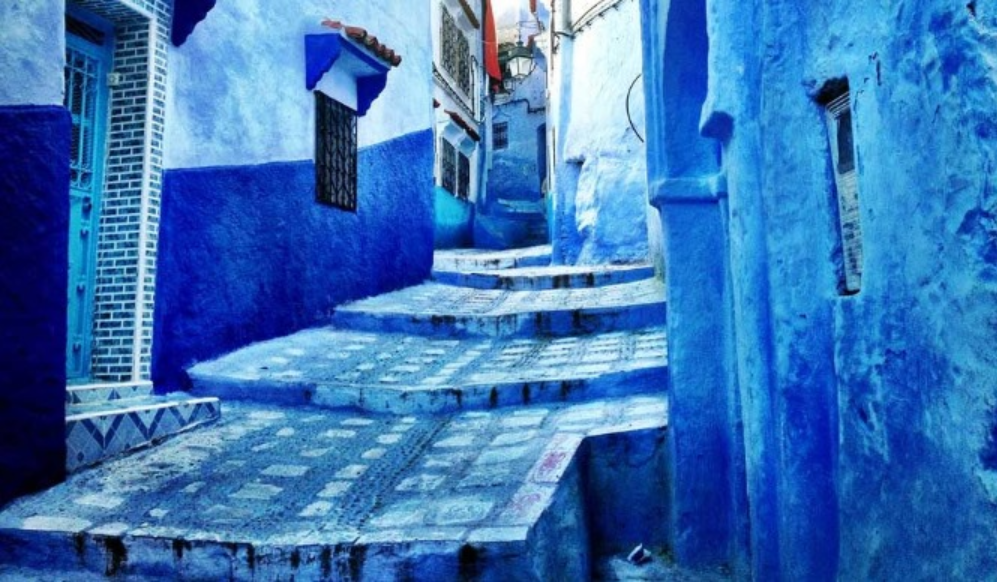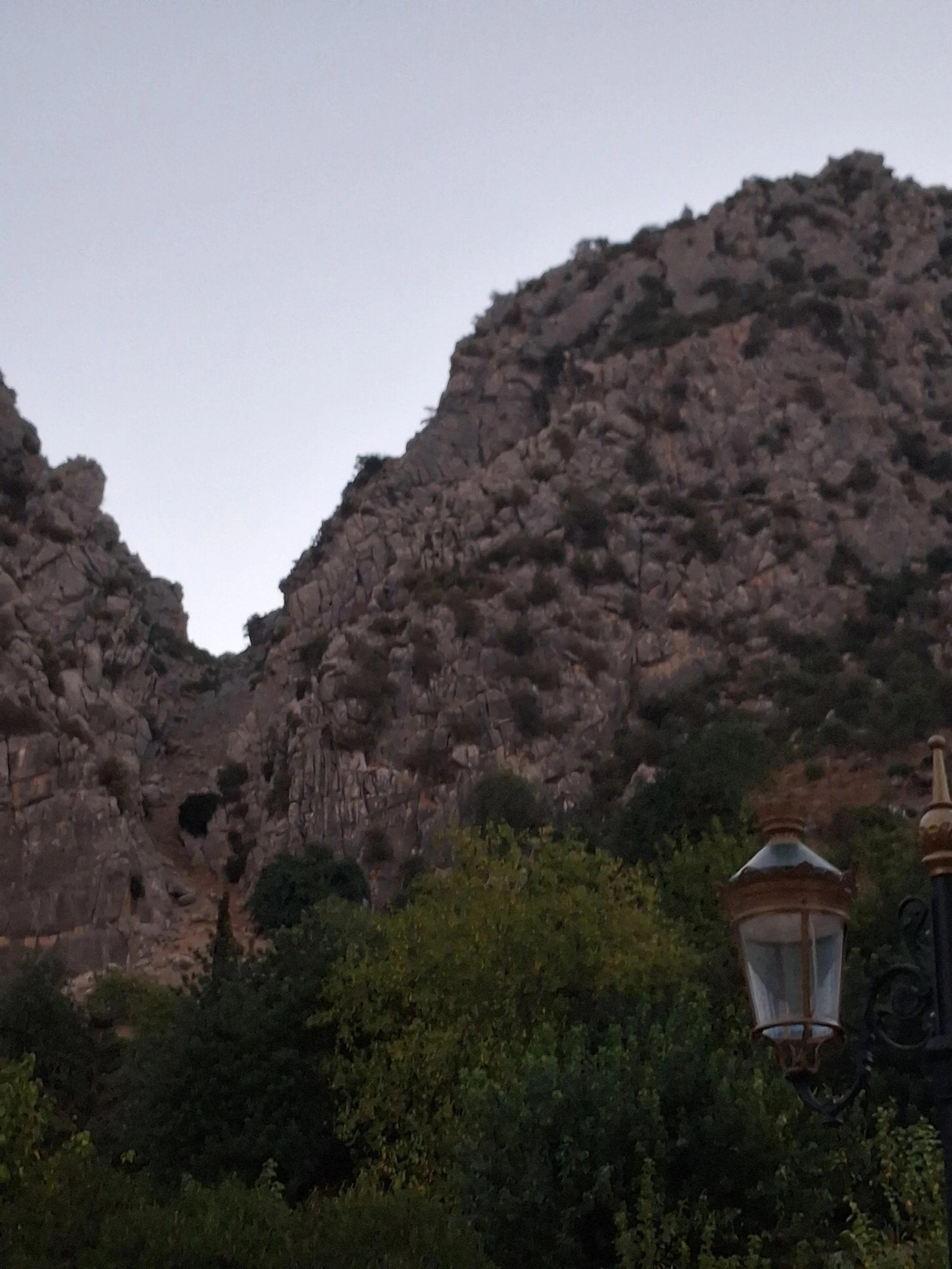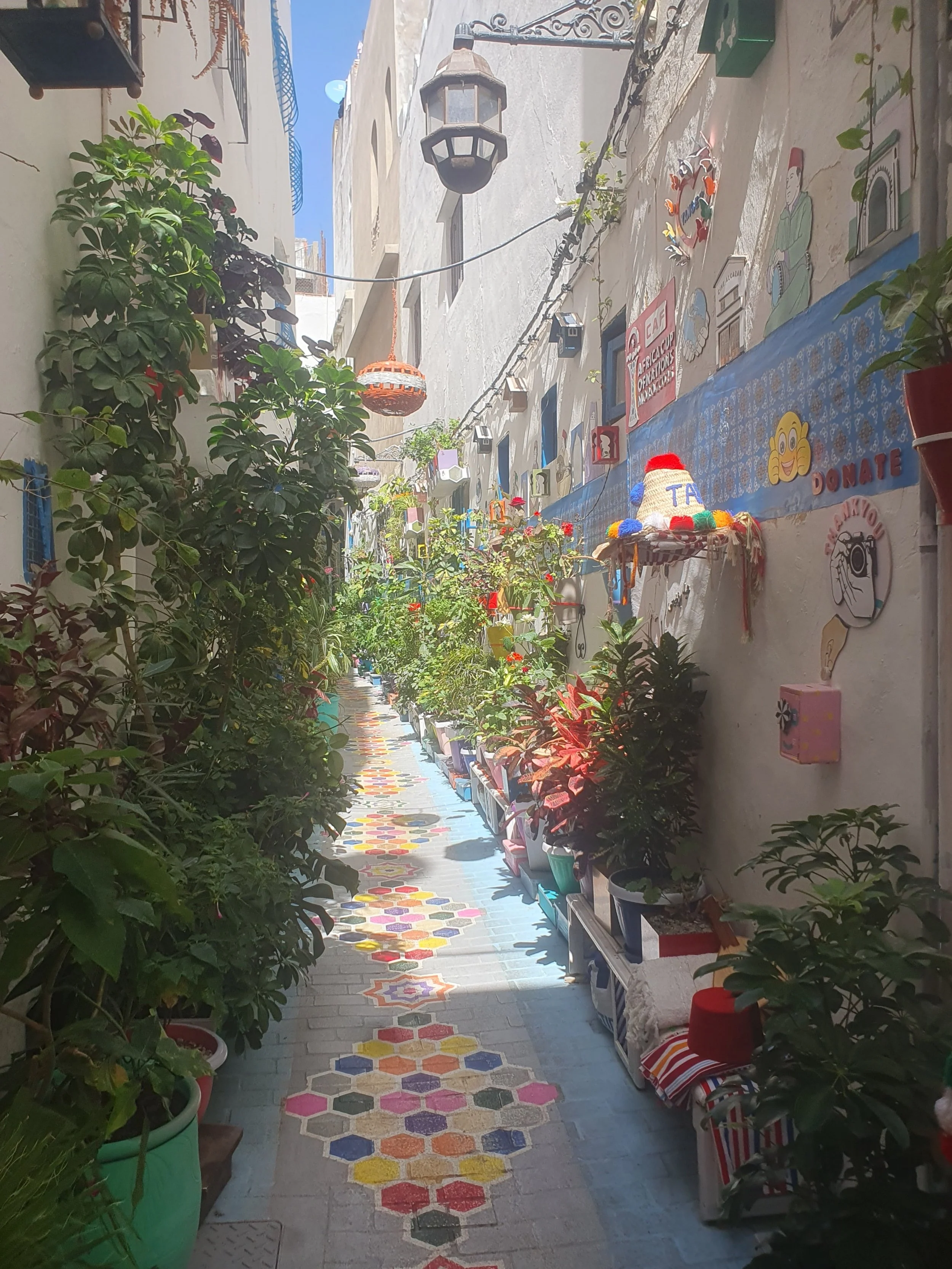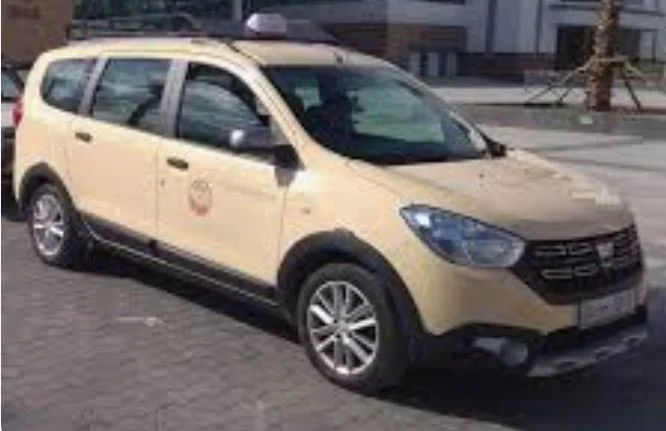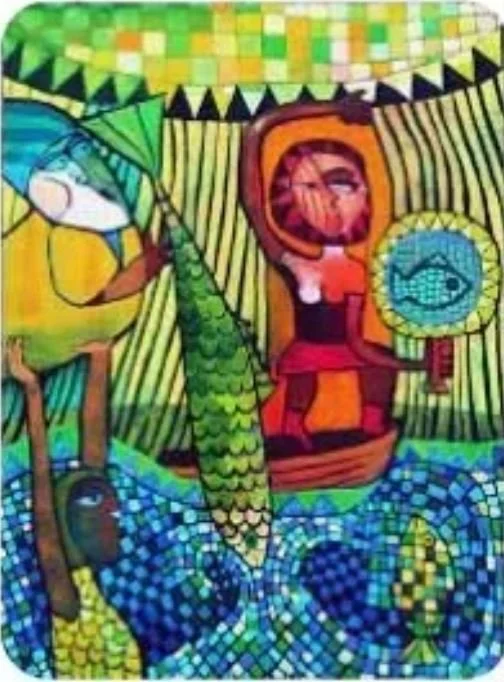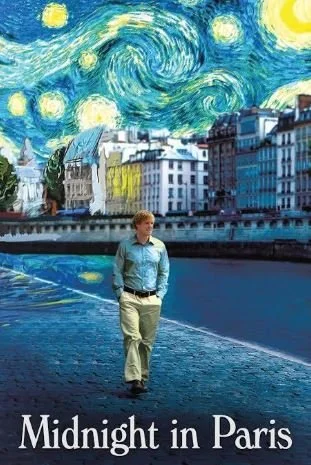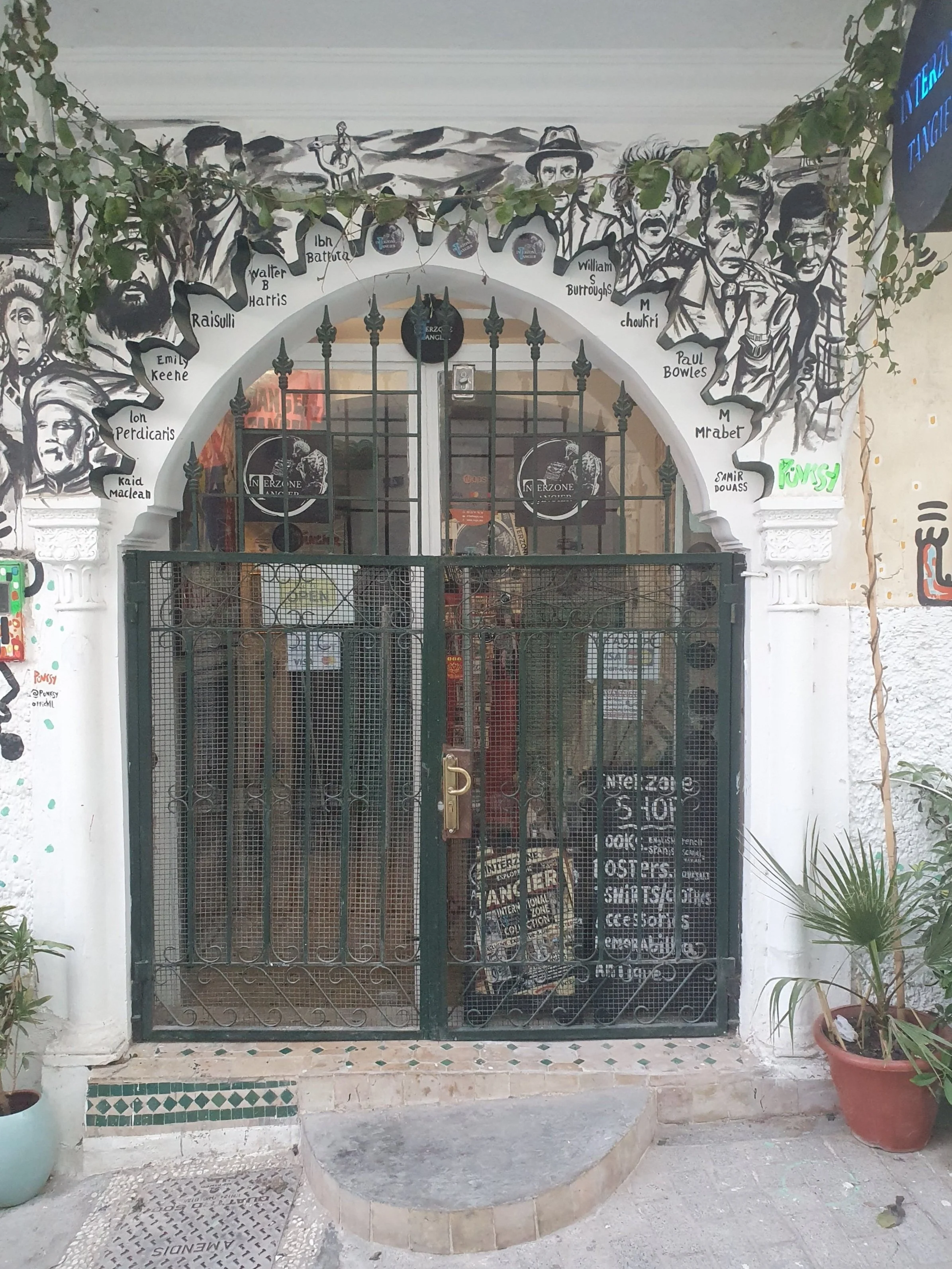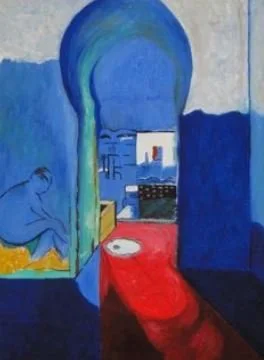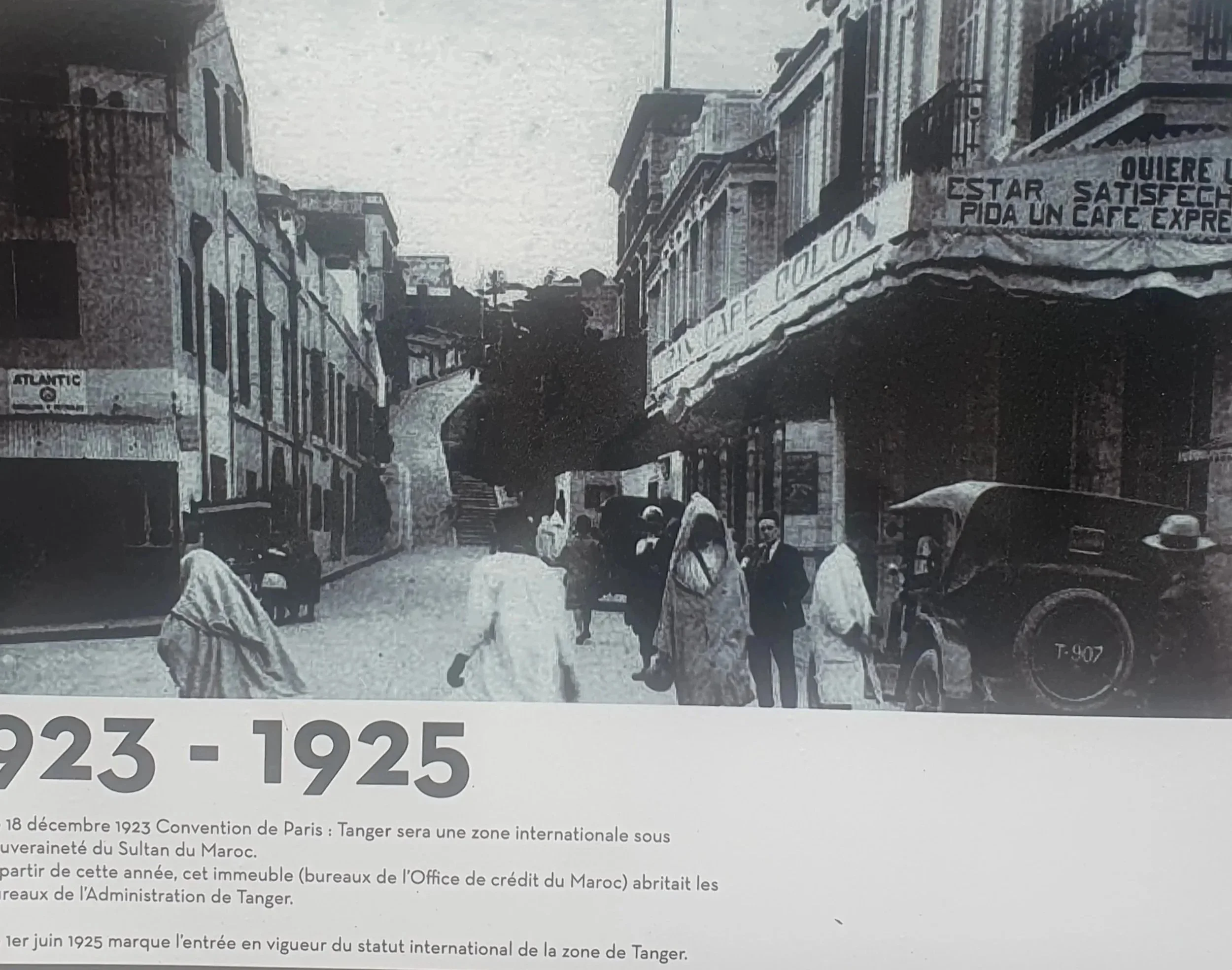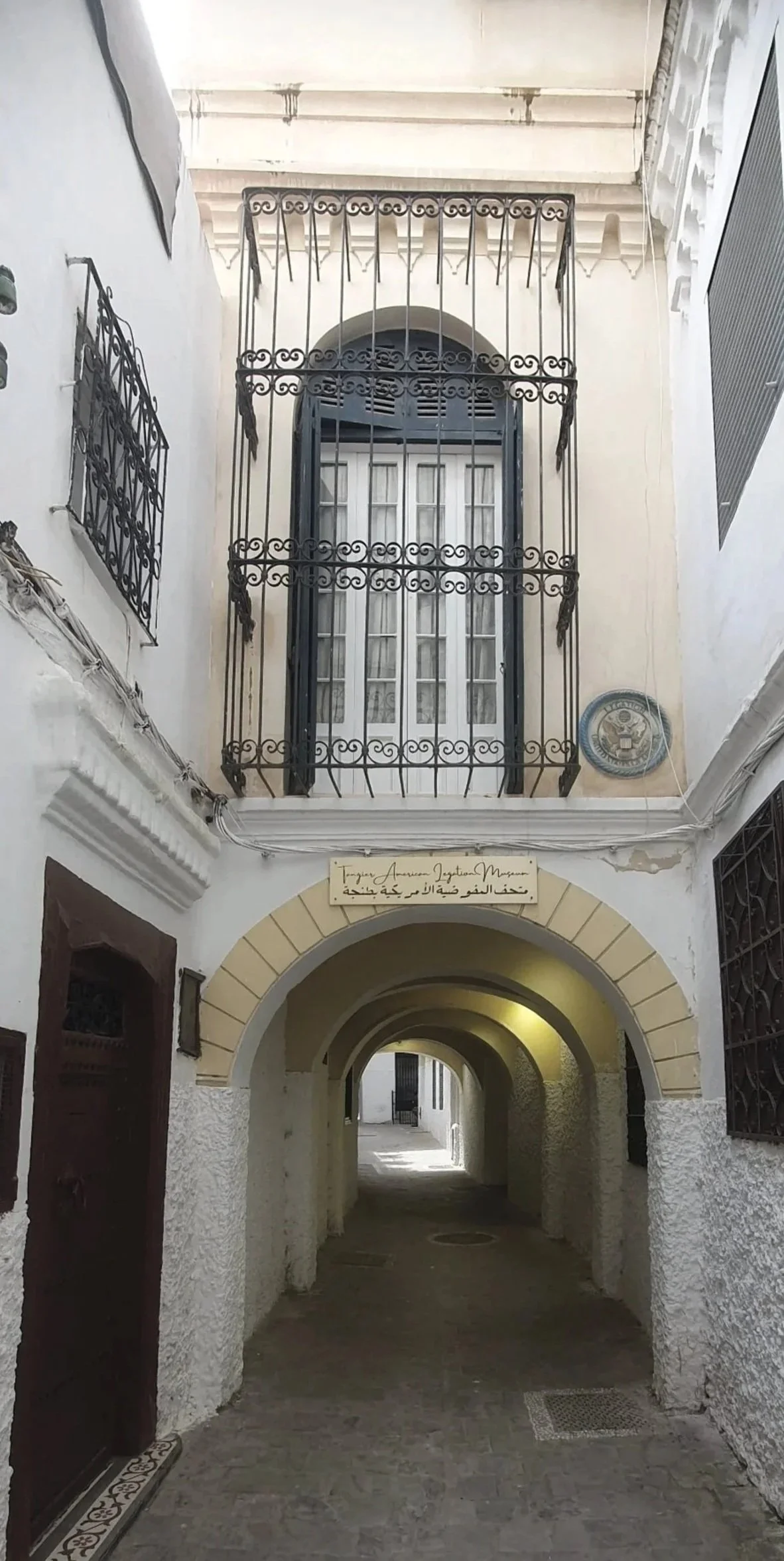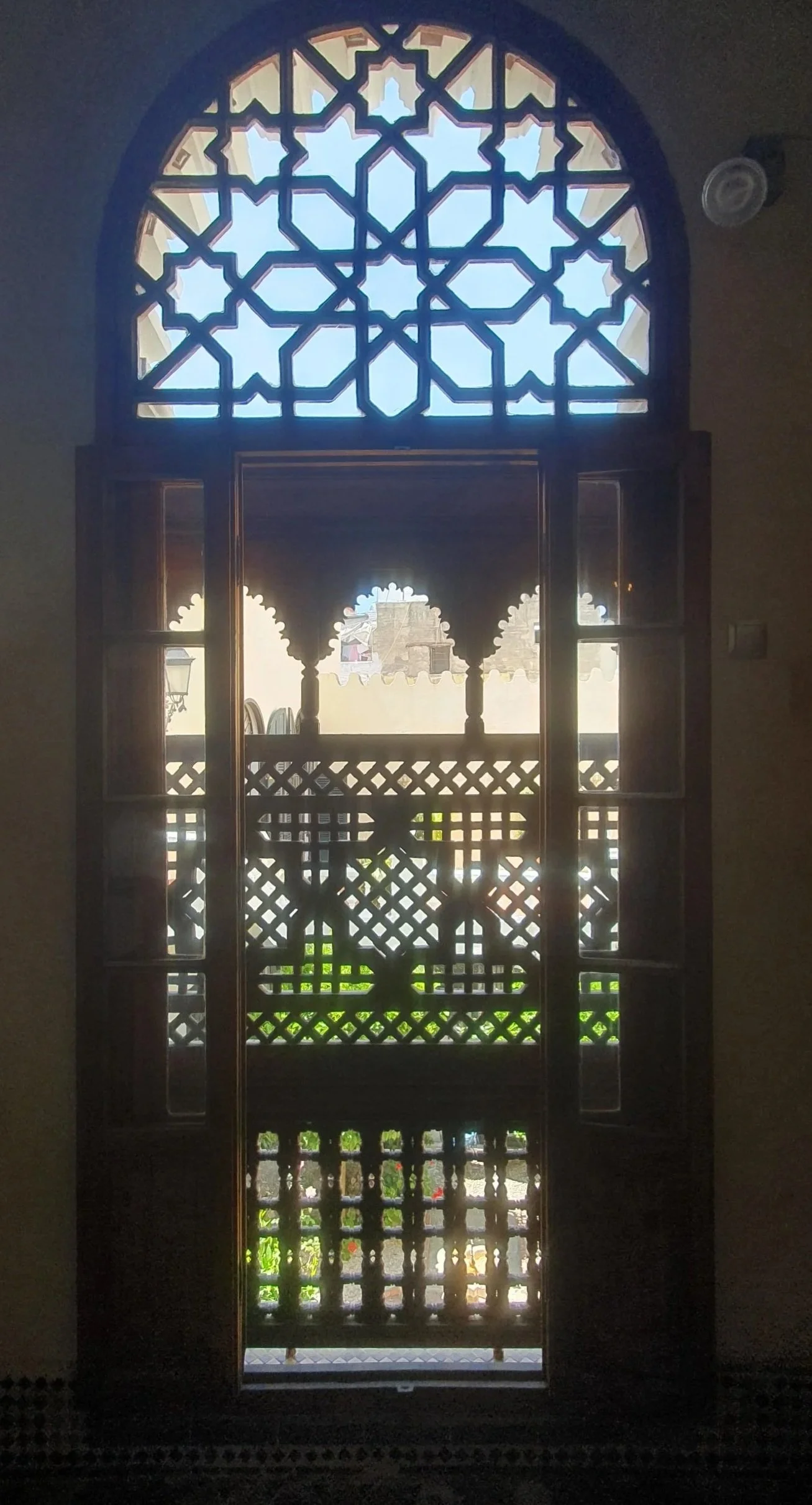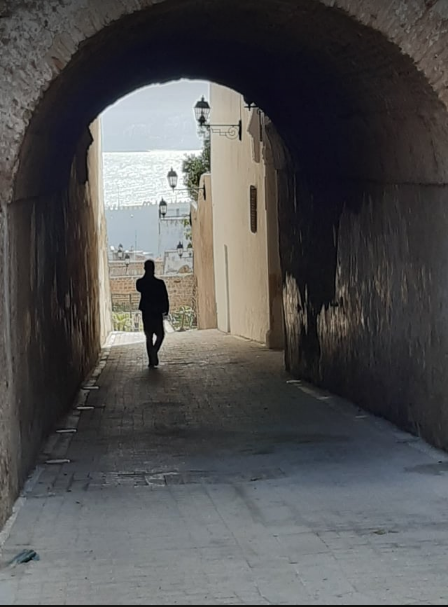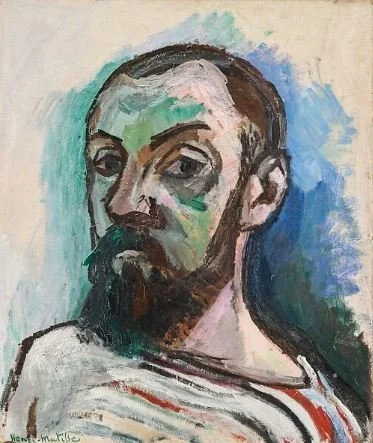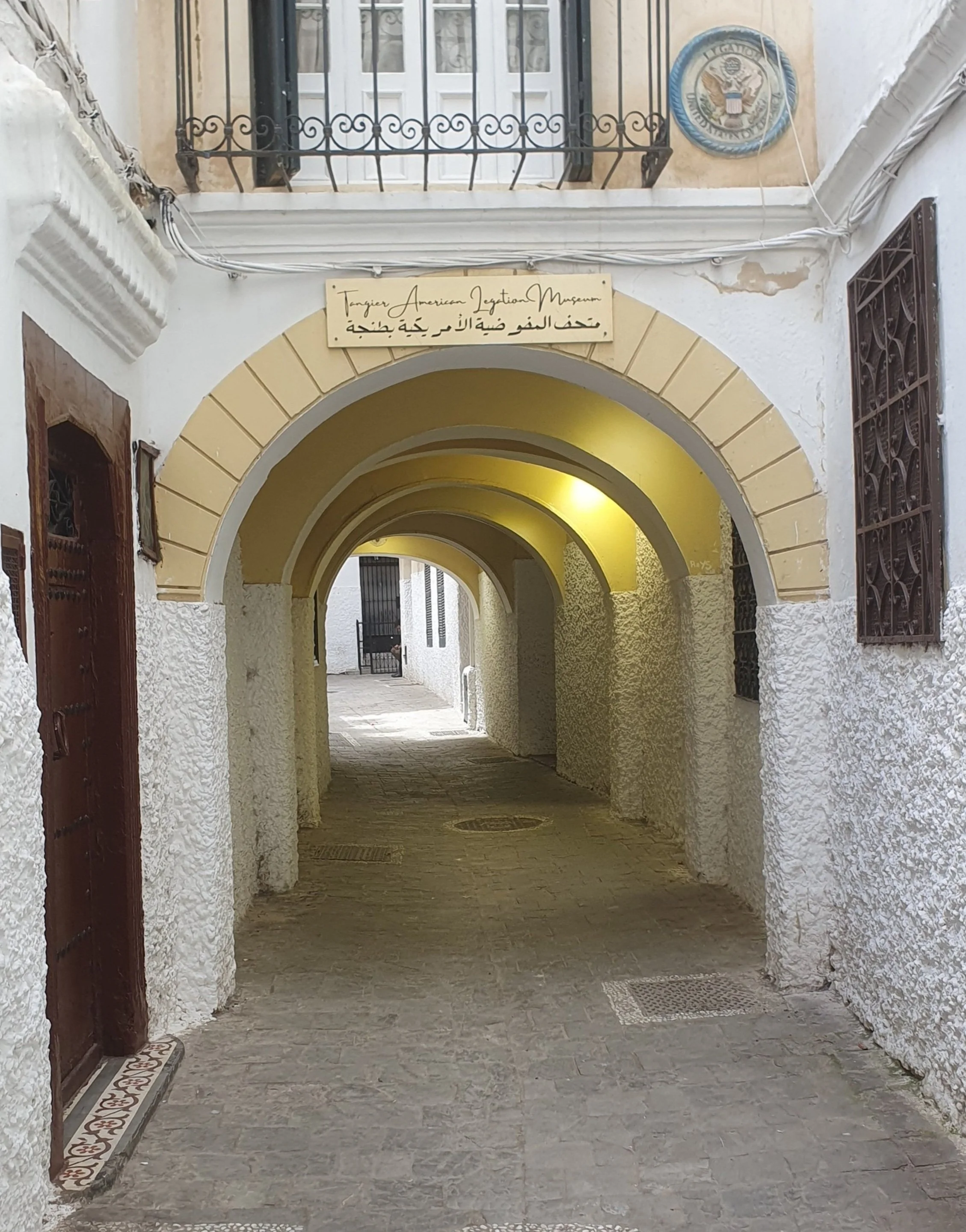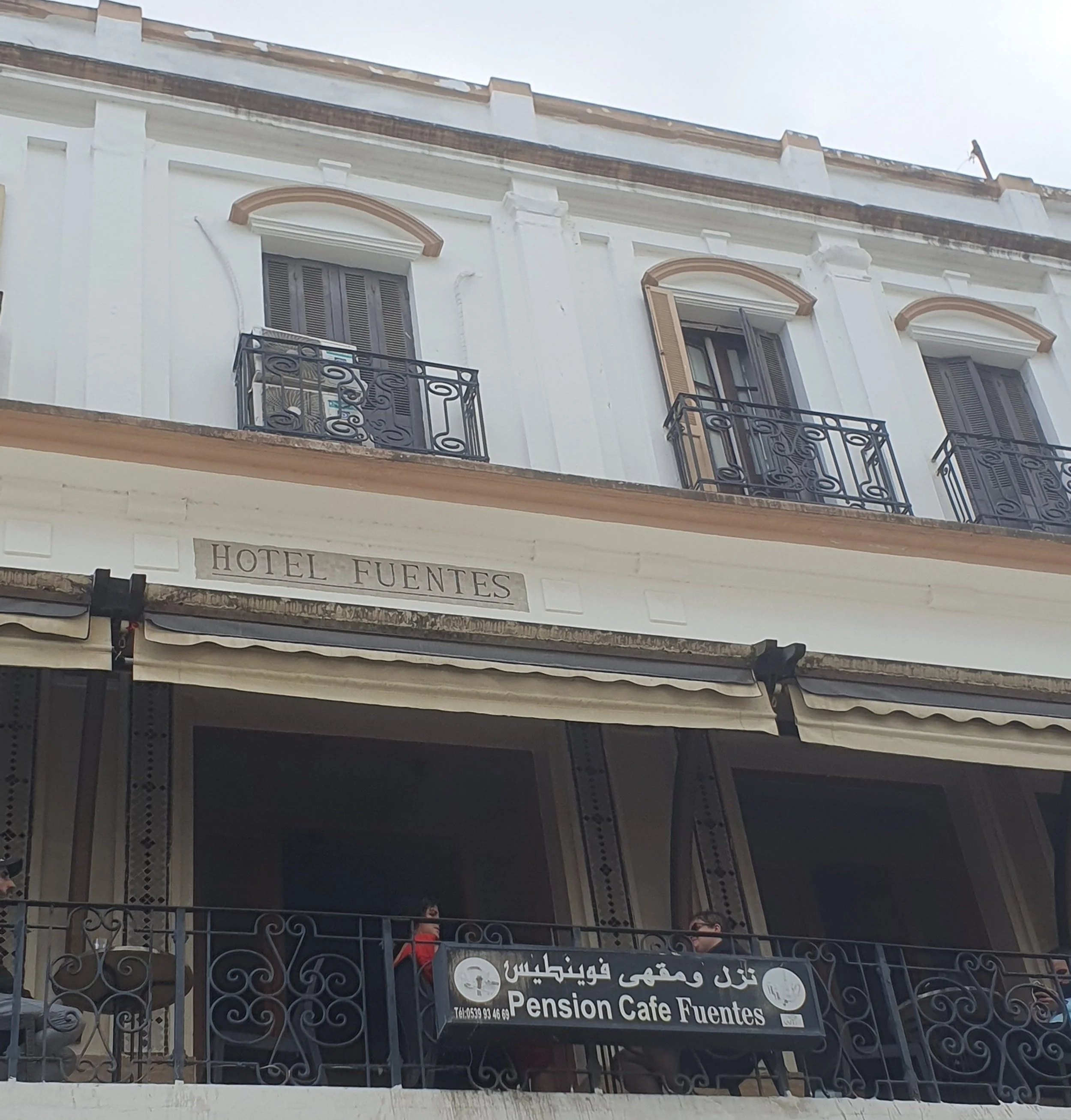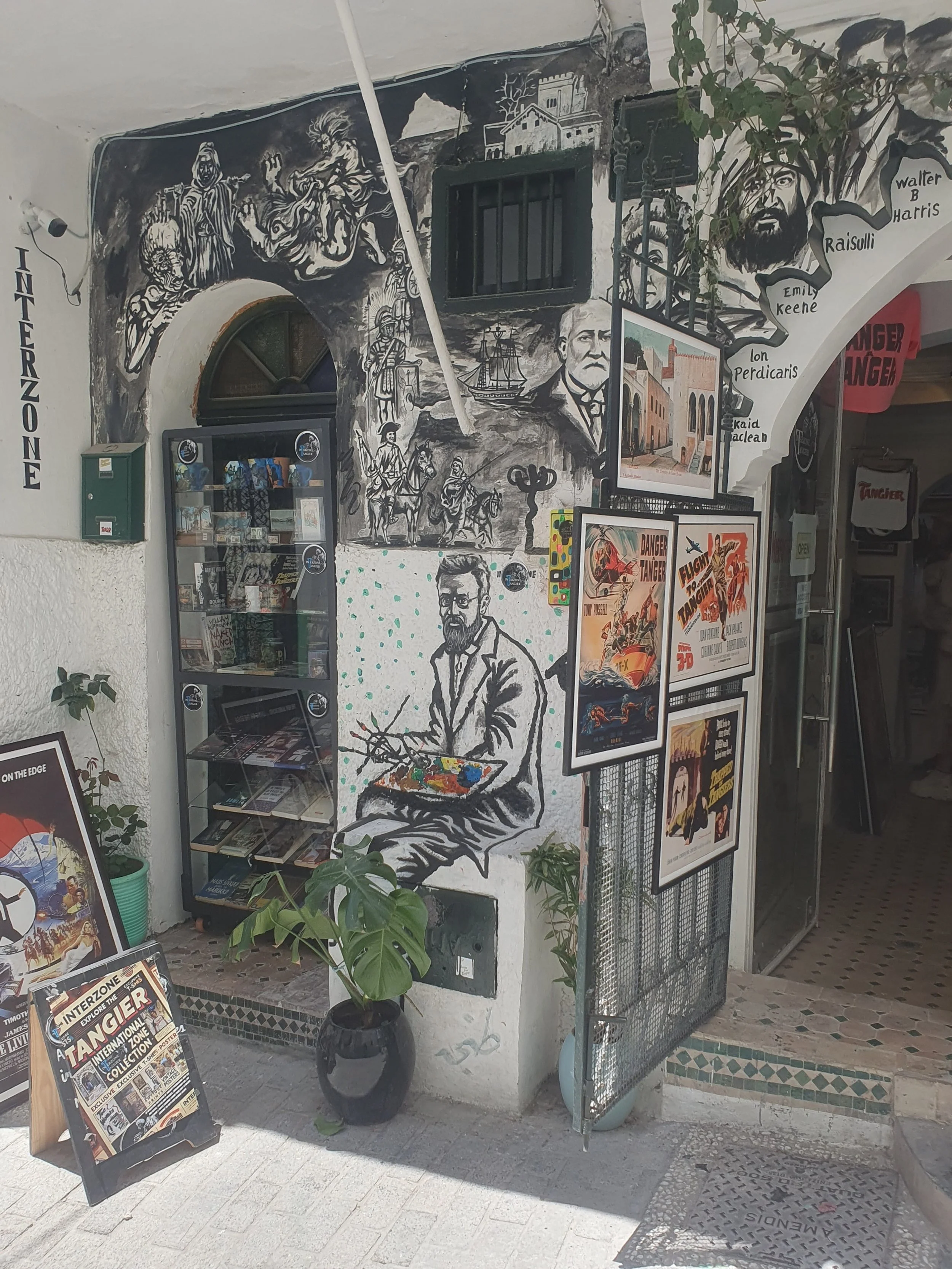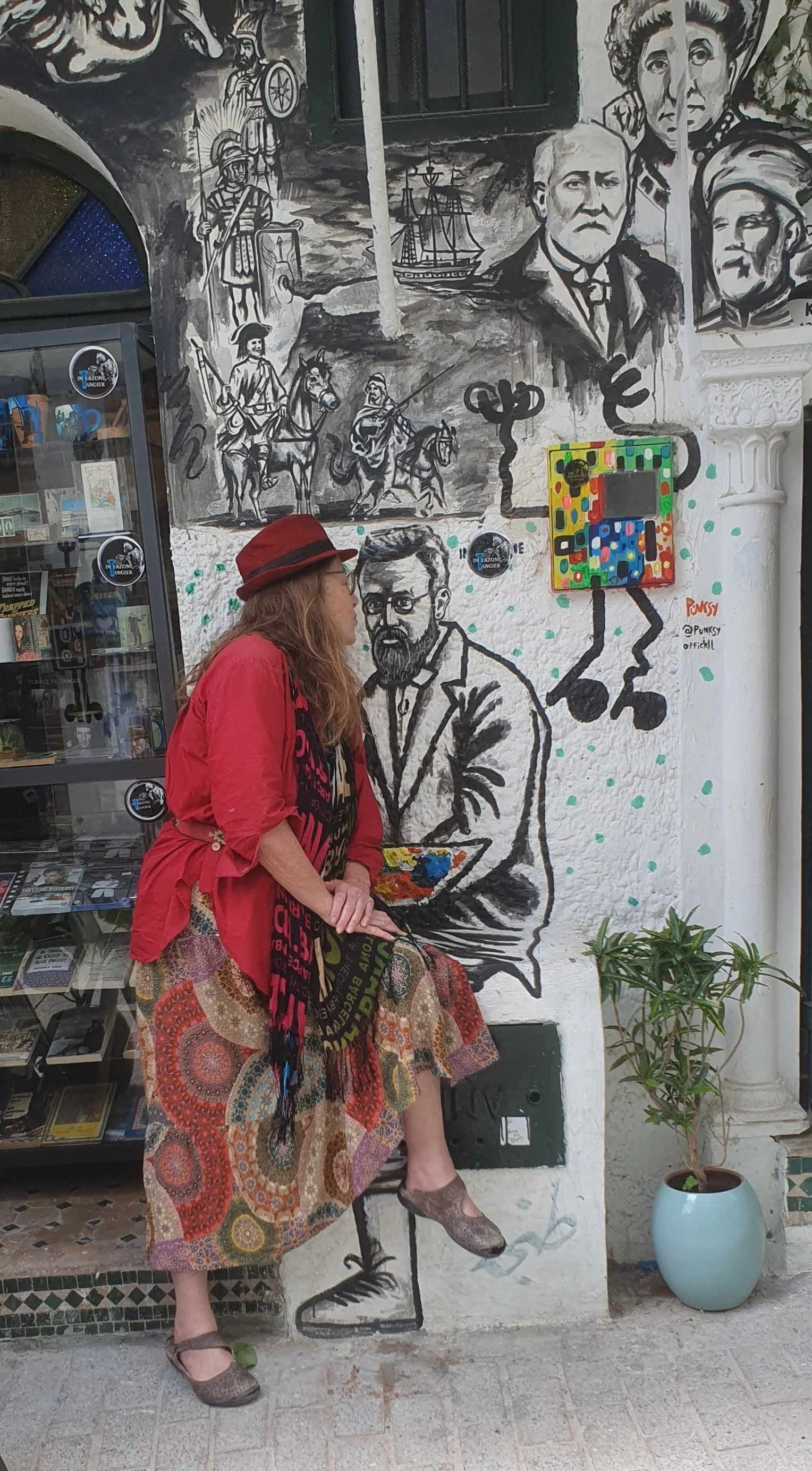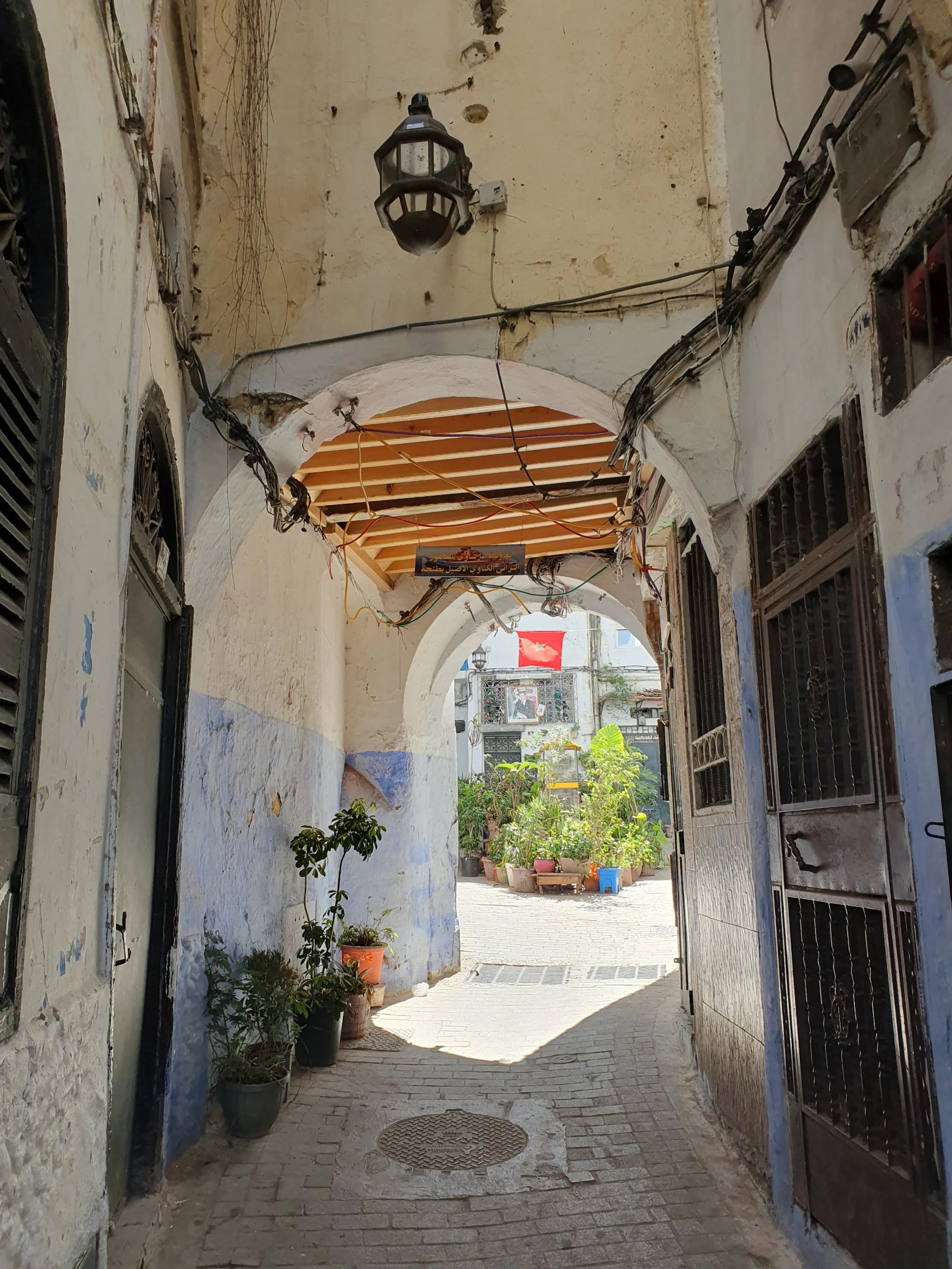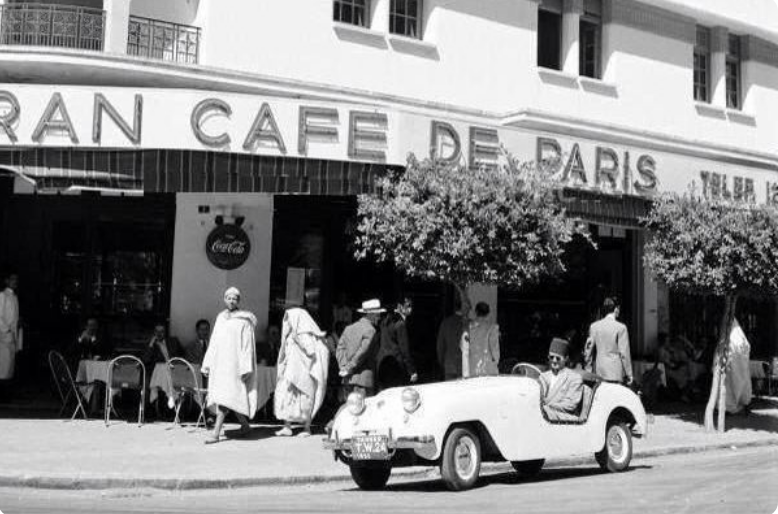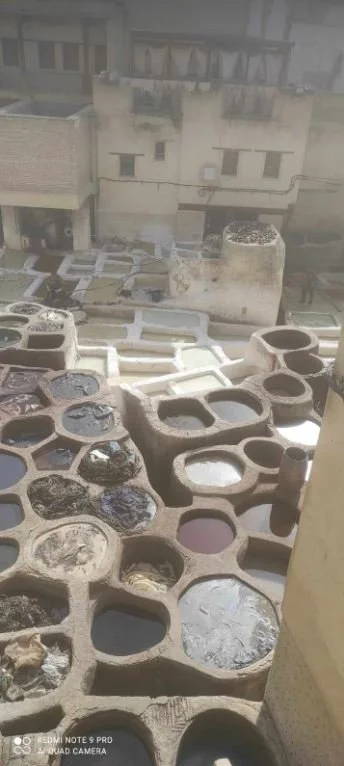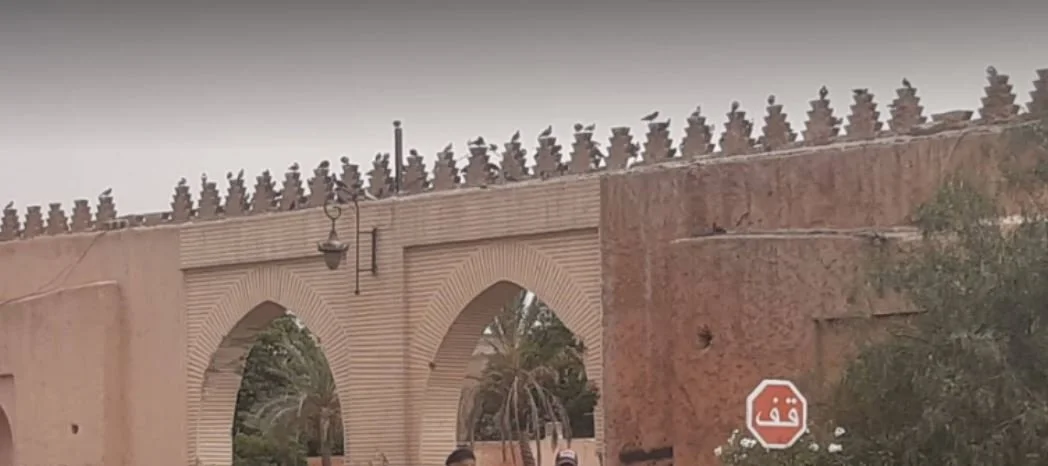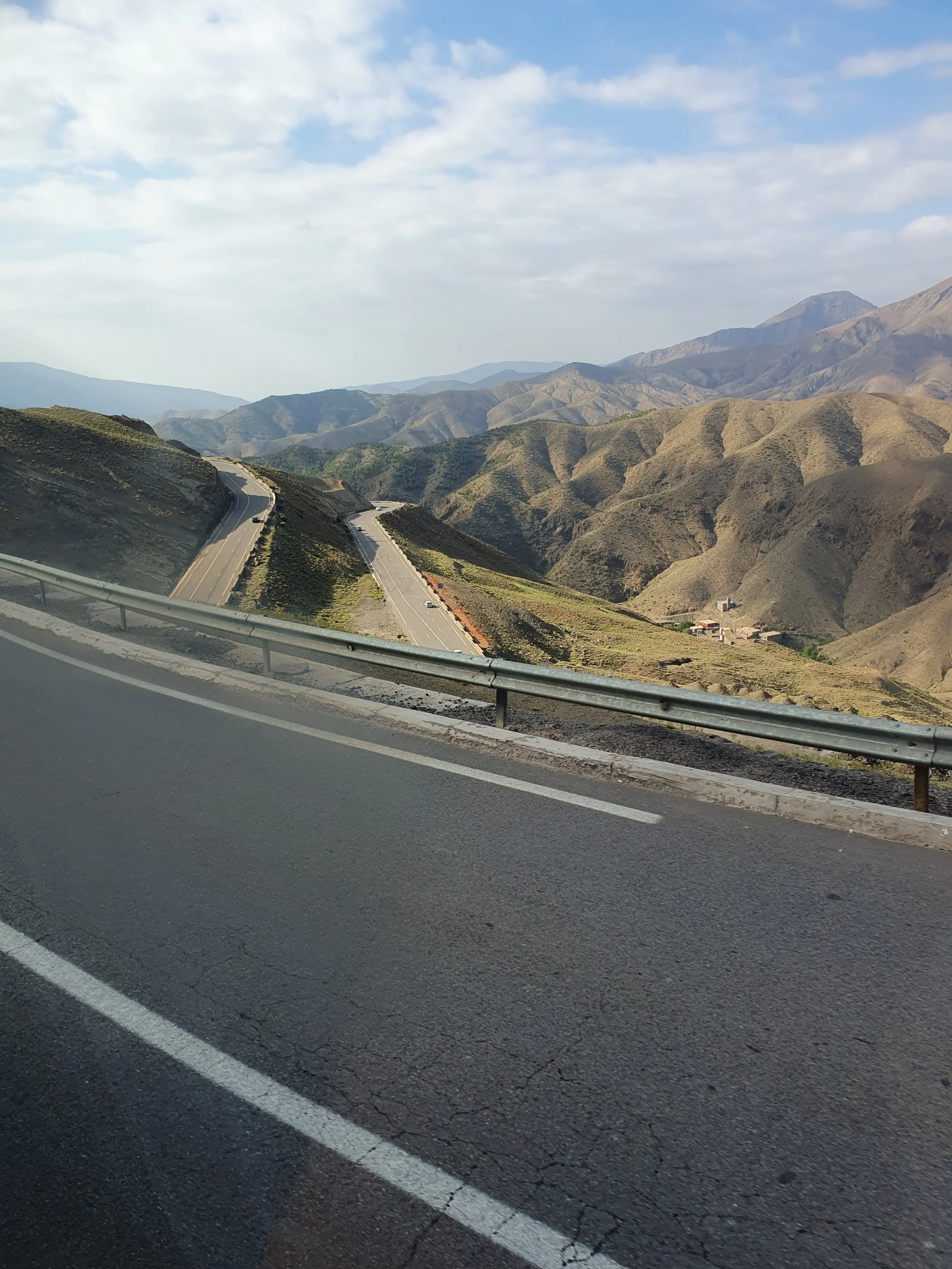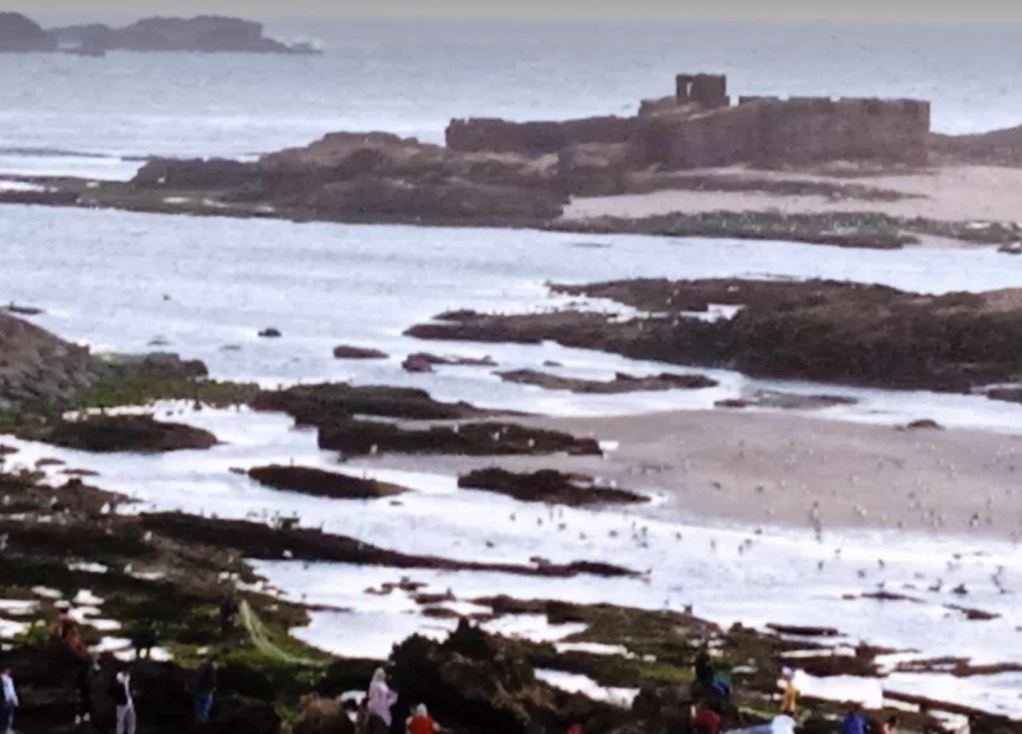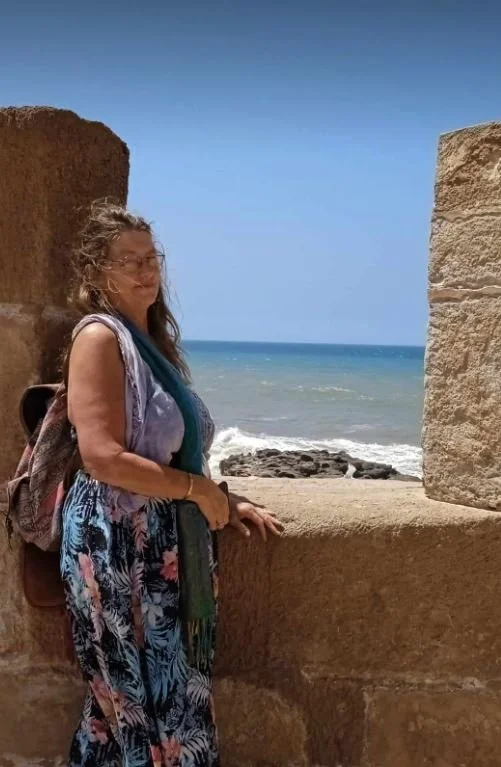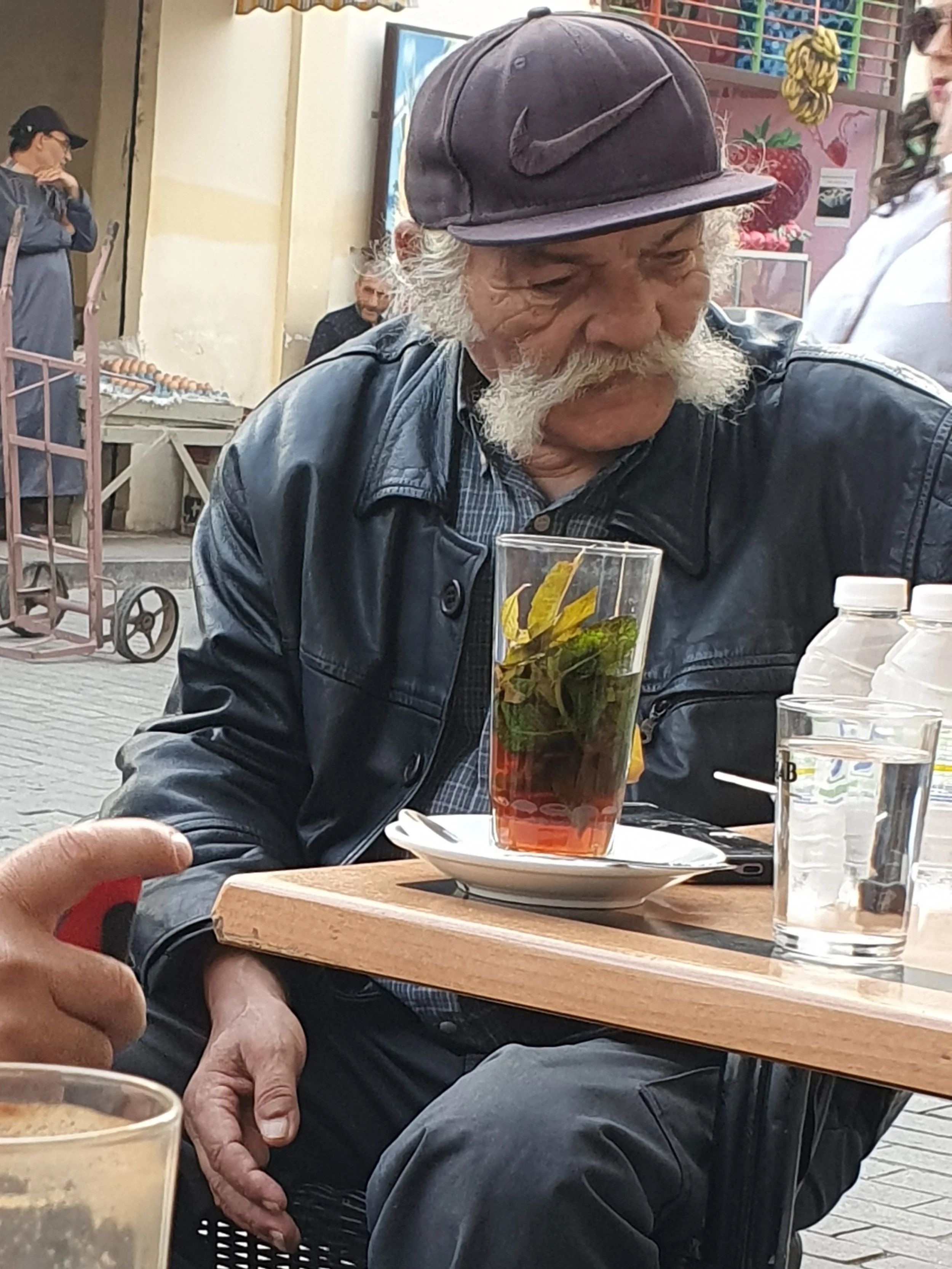The Blue City
A Day Trip from Tangier - Is it really that blue?
A Day Trip from Tangier
Morocco’s Blue City
Chefchaouen
Is it really blue?
I’ve now visited twice – a longer stay in 2019 when I first arrived in Morocco, probably still getting over jet lag, a flight of 30 hours from Canberra/Sydney to London (including stop in Qatar), flight to Tangier and job interviews.
As it turns out, that first visit when I was intending to stay at least a year, fixed with year-long job and flat contracts and good prospects – well, one of the things about Tangier is that you never know what is going to happen. In that case, just after arrival everything fell apart. After two months I was packing my bags again and heading off to Europe and to get stuck in London for covid.
But my brief stay in Tangier did include a trip to Chefchaouen. (said shef-show-en)
Is it really blue? Like you wouldn’t believe!!! It is a treasure trove of photos to impress your most reticent great uncle.
No colour filters. This is what it actually looks like!
In the old medina – the maze of streets and alleyways in the old part of town – the bottom two metres of all the buildings are painted blue (to just above head height).
At least.
In some areas the whole wall is painted blue. Sometimes even the street you are walking on!
With slightly varying shades, with shadows on the walls, and steps which disappear up and out of sight and around corners – an invitation to all adventurers whose curiosity demands they explore to find out what is next along that pathway, just out of sight.
The blue pales in the sunshine in some spots, deepens like the sea in others catching the shadows, and reflecting back on itself for yet another shade. It is all kept fresh by a painting fiesta every couple of years, where everyone pitches in to repaint everything to keep it fresh.
Add to that some streets decorated with lovely contrasting deep green pot plants. And don’t forget the cats, who all oblige by posing for your album of photos.
In Morocco I find the angles and spaces between the medina homes a constant invitation for amazing photos – I must have taken the same photos a hundred times in some spots. Alleyways and stairs that sneak off around corners, beckon me. I love the old studded wooden doors with brass knockers, and the arched gates, doorways and window frames sometimes fixed with stained glass, which all echo of an intriguing and amazing part of the world.
Add to that the prettiest blue colouring in everything, and you get one of the most beautiful places I’ve been.
Why is Chefchaouen blue?
The second time I went to Chefchaouen was another story. For just one day in October 2025, and another movie, another misadventure.
If you come to Tangier without onward plans, be warned. You may think you are choosing, but it is Tangier which does the choosing!
My first stay I planned a year, and was gone in two months. My second visit was planned for two months. Three years later I “left”. Which is why I am still here! This time it was a planned visit of two weeks for a Chris Pratt series – Terminal List on Prime. But Tangier wasn’t letting me go so easily.
First I delayed for some health checks – which were more exhausting than the original problem. But at least I was given a 100% clean bill of health. Then I delayed to do a favour. And then to complete the wrap up of the favour. By then there was another movie – this the one in Chefchaouen.
It is a Moroccan series that screens every year in Ramadan, something fun that’s now in its 20th Ramadan year. This one (for Ramadan 2026) is a 33-episode series of 30-minute shows, weaving the story of 3 families in Chefchaouen. I was at the very beginning of the very first episode, and had to behave like a… tourist!
Luckily for me.
I’ve got it on good authority that it would not be a wise move for me to give up my day job to be an actor. My place is from the other side of the camera – maybe even to write a script.
So, with all my years of collecting trivia around Tangier, this brings us back to the question:
Why is Chefchaouen blue?
There are four reasons I have come across over time.
Watch the Goat’s Horns
Choof! Look! (Shooff)
Morocco isn’t Arabic. It is Amazigh, or Berber (derived from the word barbarian). The Berber people are from the Rif Mountains, and widely spread across this north western corner of Africa, including Algeria, Tunisia, and down to Mali in the south.
The colourful dress of the Berber women. This one is posing at the Phoenician tombs near Cafe Hafa in Tangier, with a backdrop of Spain.
That is also why Darija (Moroccan Arabic) is so far different from Arabic in the Levant. It is very heavily laced with Amazigh words and sounds (as well as French, Spanish in Tangier, Italian in Tunisia etc). Arabic speakers cannot understand Darija without learning how. It is a different language.
Choof means look (‘ch’ said sh), and chauoa (shower) means goat’s horns, referring to the shape of the hills above the town.
Its history is similar to many parts of northern Morocco. After the advent of Islam around 610 AD, the Arabic Moors swept across northern Africa in the late 600s during the conquests of the Arab Umayyad. The local Berber people initially resisted Islam, but over the centuries they were gradually converted.
The Arab Umayyad then crossed the strait into Spain in 711 – which explains the Alhambra in Granada and the mosque at Cordoba, the casabas (Spanish for kasbah, or castle), and Arabic influence of the architecture in southern Spain. They stayed until they (the Moors), together with the Jews were ejected by the Catholic Queen Isabella in 1492.
These quintessentially Arabic arches and carvings are part of the Alhambra in Granada in Spain. Its construction was started in 1238.
The Chefchauoen kasbah or castle was established by the Spanish in 1471 against the Portuguese, and was quickly settled by the Moors and Jews forced out of Spain. Morocco had a significant Jewish population for many centuries.
Morocco’s Jewish population went up to 250,000-350,000, but has been declining since 1948, when Israel paid governments – including the Moroccan government – for every Jew who left Morocco and resettled in Israel. The current population of Jews in Morocco is around 2000-3000. The Moroccan Jewish population in Israel is now around half a million today.
So…
Why is Chefchaouen blue? The first – and most appealing – theory of why Chefchaouen is blue is because blue is symbolically important to the Jews. Their prayer shawls are dyed with blue dye – tekhelel, which reminds them of God’s power. It is said that they painted the walls of their houses blue to honour God.
Ras Al-Maa – Head of the Mountain Spring
Chefchaouen seems to be all about water. The main square itself where the kasbah is, is called Place Outae Hammam. Originally a crossroads, it was logically the location of the most important feature in town – the hammam, or bath house.
This is a special treat in Morocco. Most Moroccans go on a regular weekly basis, or even more often – to slough off the old skin and inlaid dirt and keep their skin in peak condition.
The hammam may be gone, but the kasbah and its museum are still in the square. It was built in the Andalusian style (southern Spain), and includes the emir’s residence, towers, sheds and stables, a small mosque, a garden and a prison. The building used limestone and rammed earth. Uncharacteristically the archways use red bricks fired locally, red tiles on the roof, and wooden platforms from juniper and fir trees.
If you walk up to the top of the town, you will pass the communal laundry houses which are still used as gathering points by the women even today, as well as mills for grinding grain and pressing olives for oil.
Ras al-Maa is the movie location, with amazing views over the blue village. We got a complete view, starting with the views across the town and the early morning low clouds, through the day as the sun lit up the houses, and into the evening with one of Chefchaouen’s spectacular sunsets.
Shortly after first light in Chefchaouen.
This is another reason to visit – to drink some sweet Moroccan mint tea from one of the rooftops, and maybe an almond biscuit or few, and meditate over one of the beautiful sunsets for which Chefchaouen is famous.
On a more energetic level, the head of the mountain spring – the Ras Al-Maa – is a great spot for a half or full-day hike, and in the summer a swim. From the top of town where the movie location was, past the women chatting over their washing, and the various mills. Make sure to keep looking over your shoulder for views and photos. Then just follow the river on uphill.
The Ras Al-Maa or spring is the reason why you know that the water in Chefchaouen is safe to drink. Every city in Morocco is different, and you need to ask. Tangier has safe drinking water, and Chefchaouen – you cannot beat water straight from a spring!
Why is Chefchaouen blue? The second theory is as the name Ras Al-Maa suggests – the water. The blue is supposed to reflect the Mediterranean. This is an interesting theory, since you can’t even see the sea from Chefchaouen. It is instead famous for its sunsets over the goat’s horn shape of its lovely hills. I would have expected the village to have been red-yellow for the sunsets, or green for the surrounding hillsides, or red like the clay baked bricks used in the kasbah.
Tajine and Atay b’Naanaa
With the lovely warm climate of the Mediterranean – and in the northern Rif Mountains above sea level, an intense sun – the lifestyle for most of the year is very outdoors. Drink atay b’naanaa – tea with fresh mint. In most Moroccan cities, that means lined up in front of a café. But in Chefchaouen the business is from a rooftop with views of the afternoon setting sun, with some Moroccan almond biscuit treats.
Of course, this isn’t the only food you could explore in Chefchaouen. Tagines can be found everywhere – my favourite is the lamb one with prunes. Tagines are stewed meat and vegetables in an array of Moroccan spices, predominantly including spices such as cumin, cinnamon – yes, a savoury spice giving a great twist to the flavours – turmeric, cardamon, paprika, and ground coriander.
And something sweet, such as prunes with the lamb. Other tagines might have dried apricots, sultanas or raisins, or sweetened caramelized onion. There are many great tagine restaurants – just ask. But one place that I like is the Clock Café in the middle of Chefchaouen village. It has lovely rooftop views, and sometimes throws in menu treats like camel burgers, for the more adventurous.
Maybe try a cactus juice. In season, you can buy them on the street for 2 to 5 dirhams. The seller peels away the prickly skin so you just pick out the sweet fruit to pop into your mouth. I also love a pomegranate juice in October, or a freshly squeezed lemon with fresh mint. Fruit in Morocco is spectacular, some of the sweetest and best I have tasted anywhere.
Why is Chefchaouen blue? The third theory is that it makes you feel cooler in the summer. This is also an appealing reason, except that I would expect all of Morocco to be filled with villages painted blue, since all of it is hot.
Namoosa
Chefchaouen has your usual range of souvenirs, obviously with a Chaouen twist. There are the brilliantly coloured woven cloths which I manage to buy far too frequently for the space in my bag! There is the pottery which I also try to squeeze into my bag, quite unsuccessfully, as well as all the usuals including rugs. Uniquely, a lot in Chawan are produced by the local blind co-operative, which you can visit.
And the traditional robes or djelaba with hoods pulled up in the winter. I swear they were the inspiration for Star Wars Tusken Raiders on Tatooine (the nearby city called Tetouan also gives me pause to wonder). In winter I feel like I have giant echoes of them walking the streets of Tangier.
Winter tunics for sale, though not the hooded ones.
Trivia fact: The Tatooine home of Luke Skywalker was filmed in Tunisia, and the name Tatooine is thought to actually be derived from the Tunisian town of Tataouine (French spelling), or Tataween in Tunisian Darija.
Another interesting trivia fact, unrelated to Star Wars… or maybe not… is found in a closer look at the nice green hills that surround Chefchaouen. The biggest commercial crop here may surprise you – it is cannabis. Morocco has excellent hash, and available very cheaply. The smell is on many street corners. Although not strictly legal, most Moroccans have at some time smoked, and many smoke all the time.
Why is Chefchaouen blue? The fourth theory, that is quite popular, but getting into the realms of fantasy, is that the blue colour keeps the mosquitoes away – the namoosa. If this actually worked, I would have imagined most of the hot parts of the world being painted blue. But Chefchaouen is unique in its blueness.
However, it does also generate a significant hemp industry. Maybe find yourself a hemp bag with a Chefchaouen picture on it.
The Ramadan Series
The spectacular views of Chefchaouen from dawn through the midday sun to sunset, was not without its misadventures. I like doing the Moroccan movies, because so far they have had the best food. This one was no exception.
We spent an hour or so at dawn ooh-ing and aah-ing as tourists over the opening speech of a tourist guide. The rest of the day was just waiting. I happily read a large chunk of my Jack Reacher novel, sitting with a cat in the midday sun. Mid-afternoon, we got paid and sent off happy at the prospect of being back in Tangier before the anticipated 9pm.
40 minutes down the road, on the 2 ½ hour trip back, we got a phone call. We had to return to Chefchaouen – they hadn’t finished with us. There was another scene. We turned around, trundled back to Chawan. The car was full. With 5 of us, I scored the middle of the back seat…
Nearly 2 hours after leaving, we were back at Ras Al-Maa at the top of Chefchaouen. And we returned to the main pastime of extra work – waiting.
After about half an hour, it was official. They were finished for the day, and no, they didn’t need us after all. We had now got in a Chefchaouen sunset to match the morning scene’s sunrise, but movie days aren’t usually short. We had left Tangier at 4am, and didn’t get back until 9.30!
Why is Chefchaouen blue? – Spoiler Alert
I give you fair warning! If you are a romantic, here is the spot to stop reading. If you enjoyed the above reasons, from historic to absurd, stay with them. Because as a local I have had time to discover the truth about Chefchaouen, and it has none of the lovely images of the reasons given.
The reason there are so many theories may well be because the reality is mundane. I have met more than one person who was either from Chefchaouen, or visited there from Tangier as a child, maybe 50 years ago. The truth is, that in the 1970s, Chefchaouen was not blue.
The blue is a thing that has grown over time. The locals realized it was an attraction, and built on it, painting more and more of their streets blue. Tangier medina has spots like this now too, if you wander off the main souvenir streets – little alleys painted blue and filled with lush green plants, and always cats.
This pretty medina street is not in Chefchaouen, but in Tangier - maybe the beginnings of new rumours.
And to be honest, they have created a beautiful place to visit. I wonder, in the end, as the truth gets buried by the rumours and stories, does it really matter? Even in the winter it is a photo album of delights. It is a tranquil place to spend a day, or even a few.
There is a lot to be said for meditating on a beautiful sunset over the goat’s horned mountains, Moroccan mint tea and some almond biscuit treats, maybe a hike up to the spring for a swim in the Rif mountains.
And the secret of the truth can stay between us if you wish.
Just take your album of amazing photos, repeat your favourite theory, and make your friends and family want to visit what is in the end one of the prettiest places I’ve ever been.
How to get to Chefchaouen from Tangier?
Most of the information is distressingly set out by people who fly through. The information is bad, because they didn’t stay long enough to find out how things actually work in Morocco. The best way to get there is the way the locals do it. By the grand taxis.
Catch a share blue petit taxi to the old CTM bus station, or Autasa, about a 10-minute ride behind the train station along the west side of the train tracks. Here someone will direct you to the appropriate fawn coloured grand taxi.
These taxis are like mini buses. They have fixed routes, and fixed fares. The advantage is that they are smaller and more comfortable, and go as soon as they are full – 6 people, rarely a wait of more than 10 or 20 minutes. The fare to Chefchaouen is 70 dirhams per seat.
A grand taxi, with its red logo on the door. They will sometimes pose as normal taxis, so always check the price first. The grand taxis will always start when they have their full quota of 6 passengers.
If you make an early start, you can do a day return trip – about 2 hours 17 minutes each way. The return is from the spot where they drop you off. Alternatively, book somewhere overnight, relax and enjoy the sunset.
There are also buses, but the taxis are more comfortable, more frequent, faster, don’t require pre-booking, and around the same price.
The Naughty Boys of Tangier
Tour the places where the Beat Generation used to hang out in Tangier. They are still there.
A Tour of the Darker Side of Tangier
An unknown history of Tennessee Williams
Jack Kerouac and the Beat Generation
What did William Tell have to do with Tangier? – You won’t believe the answer!
Tour the darker history of Tangier, have a drink at Jack Kerouac’s bar, and decide for yourself!
The movie Midnight in Paris with Owen Wilson (2011), romantically visits past writers and artists from 1920s Paris, such as Ernest Hemingway, Picasso, and Henri Matisse. A Moroccan parallel might be called Kief in Tangier with Hemingway, Kerouac and William Burroughs. But it would be a much darker story. The truth behind the Beat Generation and Henri Matisse in Tangier in the 50s and 60s seems more dark rather than romantic.
But first, what was the Beat Generation?
The Beat Generation was a creative movement from the 1940s to the 60s, which rejected conventional narrative, growing materialism, and social values for freer self-expression, including spiritually, sexually and through psychedelic drugs.
The phrase was first coined by Jack Kerouac in 1948 talking about himself in contrast to the lost generations of past writers, much as in Midnight in Paris. He flippantly referred to himself as beaten down, beat up and beat out. And it stuck. The International Zone of Tangier (1923-1956) offered freedoms that to Europeans of the time were scandalous. William Burroughs popularized one of its writing techniques, of cutting up and rearranging phrases in a new order to create a whole new piece of work.
A walking tour through the darker secrets of Tangier’s writers, finishing in Jack Kerouac’s pub
Interzone – Start if you will at the cafés where Mick and Keith got stoned:- Café Hafa or Café Baba. Not just The Rolling Stones, but all of them – Jack Kerouac, Yves St Laurent, Tennessee Williams…
Flyer for Interzone, the shop, great for unique souvenirs
But I am starting at Interzone (William Burroughs’ abbreviation of ‘International Zone’). It’s at the top of the old medina near the Kasbah and 2 minutes from Café Baba. It is a museum of Tangier movie and book trivia and history, as well as a place to chill, or to browse Tangier mementos you can buy nowhere else.
Interzone, with its doorway pictures of some of the famous who have impacted on Tangier.
Around the doorway there are portraits of some Tangier significants painted by local artist Punksy, including its Beat Generation writers, from the right:- Muhamed Mrabet, Paul Bowles, Muhamed Choukri, and William Burroughs. The vapours of their stories still stir up waves in Tangier today. (You can check out who’s who on the left side of the door in my earlier blog “I Sat on Henri Matisse’s Knee”.
A print of an old movie poster about Tangier, one of several for sale.
For myself, I want a poster of the movie A Woman From Tangier, but it won’t fit in my backback. So a mug or a T-shirt will have to do. For now, let’s delve into the disreputable histories of this Beat Generation crowd.
Muhamed Mrabet – The storyteller of Tangier – who has never written a word, and yet is translated into more than a dozen languages.
He is the storyteller who can’t read.
And an artist.
His mesmerizing stories are a weave of dreams, real events, and stories heard in the cafés of Tangier, incredible journeys of humour, tragedy, violence and power, and tensions between clashing cultures. Of course, Mrabet always makes himself the central character.
Also a fisherman, he once said:
“A story is like the sea. It has no beginning and no end. It is always the same and still it keeps always changing.”
Two of Mrabat’s paintings
Born in Tangier in 1936 he even visited Interzone in 2024. Leaving home permanently at 11 years old, he met Jane and Paul Bowles in 1960. Paul Bowles transcribed the recordings Mrabet made of his stories and translated them into English.
Café Colon – It’s not just one of my favourite spots, but also one the Beat-Mates’. In fact, it is where I am sitting at this very moment writing this.
Matisse, Rain. What do you think of his version - compare to the photo on my title page.
Leave Interzone and walk uphill to the T-intersection. To your right you’ll see the arched ‘breezeway’ tunnel leading to the Bab Bhar Sea Gate, the Kasbah Museum and Café Baba. This view not only inspired me for the homepage of OzzyHopper, but is the subject of a Matisse painting.
Home of the American heiress Barbara Hutton near Cafe Baba.
But turn left instead. Follow the medina wall to Bab Kasbah or the Kasbah Gate, then go left downhill. At the bottom you will find Café Colon on your left opposite Cine Alcazar. Stop here for a coffee or a Moroccan mint tea.
Cafe Colon - the inside decor has changed, but I almost feel like I can see their echoes and ghosts.
· Paul Bowles (1910-1999) – The American writer who saved Morocco’s stories. Bowles was a writer and translator who lived in Tangier from 1947 until his death 52 years later, frequenting Café Colon with his Beat-Mates. Besides transcribing and translating Mrabet’s stories, he also wrote his own.
His most famous was The Sheltering Sky, (1949), which has been described as a novel of existential despair, and a must-read initiation for all who spend time in Tangier. It was made into a movie in 1990 starring John Malkovich.
A little earlier than The Sheltering Sky - the steep street rises from Cafe Colon up towards the Kasbah.
The other reason to pause at Café Colon is because this was where the final scene of the movie was filmed. Check out the last scene with the tram in the background – how much easier to go up that hill on a tram than by foot!
The American Legation – This museum is a secret insight into what might be behind the anonymous maze of walls that line the medina streets, initially a defense strategy to confuse the enemy and minimize information. Considering how easy it is to get lost in the medina – and how often I still do – it was a very effective device!
Entrance to The American Legation.
Originally an American embassy, the USA was the first nation to formally recognize the newly independent Morocco of 1956 when the International Zone was finally dismantled. Not only is it a grand house, and an interesting museum, but there are also little turtles to be found in its garden!
Silhouette through window and its magnificent woodwork at The American Legation.
From Café Colon, keep going along Rue d’Italie to the fountain in Grande Socco. From there, turn to your left and follow the narrow street to the next corner (past the fish market, identified by smell). Turn left again (at the Jewish Cemetery). Enter the medina from the Spanish Steps.
Paul Bowles (1910-1999) – The American who saved Moroccan music. Also a musician and composer, Bowles preserved the local gnaua music by recording and transcribing it. Find the display in the Legation. He was an integral member of the Beat Generation with William Burroughs and Tennessee Williams.
You can find meter boxes all over the medina painted like this in Mrabat style by local artist Punksy.
The TangerInn and Hotel Muneria – The hub of the Beat Generation in Tangier was this bar under the hotel, both still functioning. Mrabet worked at Muneria from 1956 variously as a driver, a cook, a general handyman and travel companion.
Go to the Hotel Rembrandt on the Boulevard and find your way down behind it from there a short 2-minute walk, and across the road from where I used to live, from where I heard the night time departures from TangerInn at closing (if I wasn’t there myself).
Mug available at Interzone printed with an old photo with Paul Bowles sitting at the front.
William Burroughs (1914 -1997) – The American author who killed his ex.
A central Beat Generation writer, defying conventions with titles such as And the Hippos Were Boiled in Their Tanks written with Jack Kerouac (1954).
In 1951 in Mexico City, the story goes that one drunken night he announced that it was time for him and his ex to do their William-Tell stunt, of shooting a beer glass off her head with his gun. She agreed.
And he missed!
To escape the lingering legal case which dragged on without resolution, he went to Tangier in 1954 for four years, where he wrote Naked Lunch (1959) which was made into a movie. He also published his short stories of a fictionalized version of his life in Tangier in Interzone.
Mohamed Choukri (1935-2003) – Moroccan author who went to school at 21 , and then wrote about his conversations with Tennessee Williams in Tangier. Choukri is an iconic Moroccan writer, an Amazigh born in the Rif mountains and lived in Tangier. He wrote in Arabic, a language he only learnt to read and write at the age of 21.
One of the Beat Generation crowd, his best-known work was a mix of autobiography and Moroccan issues, called For Bread Alone in English. It was banned in Morocco from 1983 to 2000 for its explicit sexual references. Now it is translated into 39 languages! In French it was Le Pain Nu, inspiring the name of a good tapas bar in Tangier – Au Pain Nu – in the Tanjawi style where tapas can come for free.
He is buried in the Merchan cemetery in Tangier.
Tennessee Williams – Was in Tangier for several months in 1957. Choukri wrote about the conversations between them in his book Tennessee Williams in Tangier
Jack Kerouac – was a novelist and poet and the one who coined the phrase Beat Generation. He became known for his ‘stream of consciousness spontaneous prose’. He was in Tangier in 1957 with William Burroughs and co, frequenting the TangerInn with their Beat-Mates. Many times I read his quotes which cover the walls of this cosy pub, a frequent visitor since I lived across the road from it for a space.
Tangier is still a magnet for the creative. Who knows what future famous authors might be here now – although not as romantic as Midnight in Paris, and maybe not a lifestyle to aim for. Kerouac died at the age of 47 haemorrhage from cirrhosis of the liver, and Burroughs’ ex died from a fatal party trick.
There is still character to be found everywhere in Tangier - this one still frequents Cafe Colon today, here with a glass of Moroccan mint tea.
I Sat on Henri Matisse’s Knee
A Tour of Tangier’s Celebrity Creatives
Follow this tour and stand where Henri Matisse did, see what he saw and painted.
Have a coffee where Mick Jagger slept.
Sit where Keith Richards smoked kief.
Dine in Yves St Laurent’s home.
And who was the naked painter?
These are just some of the celebrities drawn to Tangier over time. Follow their footsteps, check out their haunts. And discover Tangier’s celebrity history by stopping in at Interzone at the top of the old medina near the kasbah. See their unique collection of books, movies and curiosities of Tangier, chat, chill, or buy memorabilia you will find nowhere else.
Around their front door, local artist Punksy has painted portraits of some of the more memorable Tangier celebrities who lived in Tangier, both Moroccans, and the famous who retreated from a conservative Europe to the freer and more permissible society of the Tangier International Zone (1920s-1950s), including a full-size portrait of Henri Matisse in the exact spot where he painted Le Marabout.
Discover the haunts and eccentric lives that make up part of the Tangier history and magic. Follow in their footsteps. Stand where Henri Matisse did.
Gran Socco - the fountain on the left, archway into Rue d’Italie, and entrance to the ancient medina right of it, an entrance to the Souq Barra just right of the photo. I have my back to Cinema Rif.
Gran Socco – Start here, a perfect orientation for Tangier. The souq (market) and old medina (old town) are below the fountain. Above it is Cinema Rif, with the mosque to the right, the sea to your left. Stop here, sit facing the street and do as the Moroccans – watch the world go by over a mint tea or café au lait.
El Minzah Hotel – Follow the road on the left side of Cinema Rif up towards Gran Café du Paris at the next fountain. On the way, on your left, you will pass the El Minzah Hotel. Not only is it an excellent toilet stop, but its walls are covered in photos of the rich and famous who have passed through – not just actors, but the likes of Churchill and Yves St Laurent. Check out their bar for even more celebrity photos, and a drink if you wish.
Kaid Maclean (Sir Harry Aubrey de Vere Maclean, 1848-1920) was a Scottish soldier who became a General of the Moroccan army! Large of build, he dressed in Moorish clothes and played the bagpipes, he not only must have looked intriguing, but notoriously got kidnapped. His portrait is in the El Minzah.
Grand Hotel Villa de France – Go back down the street you came up, but turn left at the kink/corner. At the end of this street is the Villa de France.
Henri Matisse (1869-1954), French artist including impressionism, visited Tangier in the winter of 1912-1913. He stayed at this hotel, painting several paintings from the window of his room, including Landscape Viewed from a Window with St Andrew’s Church.
St Andrews Church and Graveyard – About turn, and you are facing St Andrew’s Church, built in 1905. Have you ever seen an Anglican church built with scalloped Moorish arches and a belltower shaped like a minaret? Also check out the cemetery for a few notables.
Walter B. Harris (1866-1933) – Famously, he built Villa Harris in the 1890s. Journalist, writer and traveller, he was linguistically talented and physically ambiguous and travelled into many parts of Morocco inaccessible to foreigners, and wrote about them. After his death Villa Harris became a casino – the new one is across the road. It is now a museum and a great place for a picnic or weekend yoga. You can bus or taxi to Malabata for a visit, or a picnic.
Emily Keene (1849-1944) – A writer, adventurer, and traveller who was a governess in Morocco. She married a powerful governor or Sharif and brought vaccines with her. She was a Moroccan of Anna and the King.
Kaid Maclean – the Moorish-dressed, bagpipe-wielding, kidnapped-for-ransom Scottish commander of the Moroccan army.
The American Legation - entrance under the arched breezeway on your right, the Spanish Steps just ahead.
American Legation – Fun fact: Morocco was the first nation to acknowledge the newly independent USA in 1821. The sultan presented the building to the US. It functioned as a diplomatic post until Rabat was made the capital of Morocco at the end of the International Zone era (1923-1956). This, and other history is displayed in this house established in 1821 – almost more interesting for a peek at what may hide behind those endless high walls of the medina maze of streets. This old mansion crosses over the walkway, has a garden and balconies and beautiful Moroccan architecture, all designed for occidental purposes in an oriental Maghrebi world.
It was the first
The Spanish Steps, back through the wall into the medina and The American Legation.
Go back to Cinema Rif and the fountain (the mosque will guide you). Go past the fountain and down the street towards the sea. Take the first left after the fish markets (no description needed – you will smell them). That corner has the Jewish Cemetery – another interesting part of Moroccan history. As you start down the hill – also seawards – there are some steps on your left. Go up these steps (The Spanish Steps) into the medina. You will find the American Legation not far in.
A bit of Europe inside the medina - The American Legation
Ion Perdicaris (1840-1925) and the Perdicaris Incident – This was a hot political football in 1940 when this important Greek-American author, playwright, painter, lawyer, professor, diplomat and human rights activist was kidnapped. He fought for the rights of slaves, Moors and Arabs in Morocco. Notably President Roosevelt intervened.
Kaid Maclean – the Moorish-dressed, bagpipe-wielding, kidnapped-for-ransom Scottish commander of the Moroccan army has two of his paintings displayed in the Legation.
Paul Bowles (1947-1999) – There is a special display of the musician and writer Paul Bowles, a key figure in Tangier. He was the first to record and preserve the Moroccan-Rif gnaua music, and the oral stories of Moroccan author M Mrabet.
Hotel Fuentes - This is where the artist painted naked. And painted the tables, and the ceiling of the upper floor in candle smoke.
Petit Socco and Fuentes Café – Make your way to Petit Socco in the middle of the medina, to Gran Café Central which has stood there since 1813. Beside is Café Tingis, after the old Roman name for Tangier, and one open during Ramadan, which also serves everyone at that time. As you sip your mint tea or coffee, muse at the wall opposite which was once notoriously the lineup of available prostitutes.
But opposite Central is Fuentes, a hotel and café, and also a long term feature of the square, with a little known history of being the home of the Toulouse-Lautrec of Tangier.
Antonio Fuentes (1905-1995) – A prolific artist he lived on the top floor of Fuentes. As a child he was known to paint on the marble table tops, and later he painted the ceilings using candle smoke, and apparently his norm was to paint naked. Well, Tangier is warm in the summer. Between spaces in Europe, he lived here his whole life. A prolific artist, he painted - here - til the day before he died. He admitted himself to the Spanish Hospital in Tangier, and a day later he died.
Camille Saint-Saens – composed Danza Macabre at Fuentes.
Eugene Delacroix – the French artist in 1839, and Matisse (1912-1913) also painted here.
Tangier rooftops from Cafe Baba, with photos of some of its famous visitors over time around the walls.
Café Baba – Head off between Café Centrale and Café Tingis, and a short 5-minute walk will get you to Café Baba, a Tangier haven. With views of the bay through arched windows, 76 year old Café Baba has hosted kings, dukes, actors and others, including the Beat Generation, Paul Bowles, William Burroughs, Muhamed Mrabet, Muhamed Choukri, and the Rolling Stones – all of them to smoke kief and drink mint tea or Turkish coffee. You can do exactly the same, and guess which were their favourite seats. Ask the owner, and see what secrets he will reveal.
Barbara Hutton’s house
The first female there was in 1946, Barbara Hutton, American heiress and socialite whose house is almost at the bottom of the steps of Café Baba. Now of course you can find females in any of the cafes. There are no rules. Moroccan women just mostly socialise in different places.
Interzone, with portraits of the creatives who have passed through Tangier, and a life-size portrait of Matisse himself where he sat to paint the view.
Interzone – A treasure box of curiosities, a museum and a shop with memorabilia that you won’t find elsewhere in Tangier, or just chill. Ask about the history of Tangier, or buy a memento of a mug of William Burroughs, or a t-shirt of a movie poster such as the 1959 “Flight to Tangier”. You’ll find it near the kasbah at the top of the old medina about 5 minutes from Café Baba.
Around the front doorway, local artist Punksy has painted portraits of significant Tangier people, starting with Samir Duass on the right. But in the middle, you can’t miss a scale painting of Henri Matisse himself.
Henri Matisse sat in front to paint Le Marabout. Stand where he stood. Sit where he sat. You can see for yourself the original of what he painted in Le Marabout. The scene hasn’t changed.
Samir Duass – Also an artist, Samir Duass painted a painting of Matisse painting Le Marabout!
Raisuli – A striking blackbearded Berber chief, Lord of the Rif mountains, Moor and Barbary pirate that excites the imagination, who kidnapped Ion Perdicaris and his stepson from their dining table in 1904 instigating the Perdicaris Incident, in reaction to Morocco’s anarchy.
Yes, I did ‘sit’ on Matisse’s knee. But he seems rather startled at my whispered secret…
Villa Mabrouka – Walk up from Interzone to the wall and turn right. Here you will have the magnificent view through the arched tunnel to the sea – the one that I used for the main page of OzzyHopper, and the one that Henri Matisse painted in Porte de la Casbah.
Find Matisse’s painting of this view. Can you spot where he set his easel?
Just beyond it is the kasbah square, with the kasbah museum and the café Salon Bleu with its amazing rooftop views. But turn left and exit through Bab Bhar, the Sea Gate. With Spain across the water, the Marina Bay to your right, and the best seafood in Tangier below, this is another of the amazing views from Tangier medina.
Bab Bhar (Sea Gate) from the inside.
For Villa Mabrouka, follow the path from Bab Bhar to your left, on the outside of the medina wall, first for the amazing views of the Mediterranean, then for a short walk through some medina streets, past a café with magnificent gardens and sea views, and shortly later to Villa Mabrouka.
Yves St Laurent – Here you can dine, or have a coffee, in Yves St Laurent’s home, frequented by the rich and famous including Mick Jagger. If it’s in your budget, is a boutique hotel of the first order.
View from Cafe Hafa. Unfortunately on a day when Spain wasn’t there. (They sometimes tow it away for a spa and makeover)
Café Hafa – To finish for the day if Villa Mabrouka is outside your budget, there is always the iconic Café Hafa. A short street left of Mabrouka, then right will take you right up to the top of Tangier. You will pass the Phoenician graves on the cliffs – another magnificent view of the sea. The next street on your right will take you around to Café Hafa, frequented by… everyone. All of the Beat Generation went there, even Mick and Keith smoked kief there some 60 years ago.
Which table do you think was their favourite?
How many emerging artists have been there since?
Cafe Hafa, since 1921
But even if not, the views from Hafa are some of the best in Tangier. Especially over a tea and sunset.
Best Places to Stay in Tangier
From riads to luxury hotels, whether passing through or looking for apartments or villas for sale or rent,
from cheap hostels to your 5-star and boutique hotels,
Tangier offers everything.
Read on to find out the details.
What are the best places to stay in Tangier, Morocco? Can I stay in riads in Tangier? What is a riad?
What are the best 5 star and luxury hotels in Tangier?
Are there apartments in Tangier for sale or rent? What real estate options do I have in Tangier?
Where do I find a cheap hotel and the best hostel in Tangier?
Tangier is a tourist city, so there is a huge range of places to stay, everything from your luxury boutique hotels and riads, down to your more basic airbnbs and hostel accommodation. For longer stays there are many apartments and villas which are rentable by the month and upwards.
Your best option and place to stay will depend on your needs – whether you are passing through or coming to stay. Your choice will be affected by your budget, if you have children or others with you, whether you want to be near everything, or in a quieter location with beach access.
If you have specific needs you can check out the shop and order detailed and personalised answers.
But first, what types of accommodation are there in Tangier?
What is a Riad
Welcome to Morocco where the traditional style of home or dar is a riad.
If you have ever wandered through the maze of streets of a medina and noticed that it is all walls and doors, doesn’t it make you wonder where people live when there are so few windows?
They live on the other side of those walled alleyways, and sometimes above. To a western eye where outward facing windows is normal, that flies in the face of our logic. But many of the homes in the medina, especially the better ones, are riads where the wealthy lived.
So, what is a riad?
It is very specifically a stately Moroccan home or dar, where the rich and influential lived. They are built around a central courtyard which will include a water feature such as a fountain, intrinsically tiled floors and open to the sky. This lets out the heat and keeps them remarkably cool for the climate. Larger ones can have whole gardens in their courtyards.
Many of them have now become accommodation for tourists, and a must stay experience for every visitor to Morocco. An example for viewing is the American Legation. Now a museum, it was originally a stately home before it became the American consulate and the from the days when Morocco was the first country in the world to officially recognize the fledgling United States of America. It is in the medina near the Spanish Steps.
Riads are generally built upwards. While space is not an issue in Morocco, for safety the villages and towns were kept densely packed – so homes went up, not out. A riad can have several floors with rooms opening off stairwells and small balconies around the courtyard ‘well’. The rooftop is the pinnacle in every respect. In Tangier this often means sea views of the Mediterranean, of Tangier Bay, and Spain. These can be the perfect place for breakfast, a Moroccan mint tea or coffee break, or an evening drink, especially in the summer.
The ancient medina is full of beautiful riads, many now available for a stay with prices ranging from the luxurious and well appointed to the cheaper ones for a more moderate budget. Some names include:
Riad Tinggis
Riad Mokhtar
Riad Dar Nour
The Morocco Club
Kasbah Rose
Top of the Range – Villa Mabrouka
If you want the very, very best, there is one place to stay which surpasses everything else in Tangier. This is the Villa Mabrouka at the top of the medina. Tangier seems to have always been a magnet for the creative and the rich.
Villa Mabrouka was originally the home of Yves Saint Laurent and where he entertained guests such as Andy Warhol and Mick Jagger. Designed in the 1940s style with a blend of traditional Moroccan and English country it has 12 rooms and comes in the range of $500-1500 per night. With beautiful gardens and superbly designed rooms plus a gourmet restaurant, it is the superlative stay in Tangier.
Boutique Hotels
What is a boutique hotel, and how is it different to a standard 5-star hotel?
These may often be riads, or were grand houses in the past. The more expensive ones will have suites, not rooms. They tend to be smaller than hotels with a more intimate feeling and a greater focus towards an artistic flair, and can have just 3 or 4 suites/rooms, or many more (though usually not over 100). Often they are beautifully renovated riads, and can start from as little as $40-75 per night and even less.
At the other end of the scale they can be very grand riads with magnificent garden courtyards, and prices reaching upwards of $300 per night.
Boutique hotels are more personal than hotels, and right up there with style and service. Some worth noting in Tangier include:
Chez Josephine
Nord Pinot
Tangerino
Narcia
Hotels, from 5-star to the beach
If you are looking for luxury hotels in Tangier, there are plenty of options. Giving you rooms rather than suites (suites are of course available), Tangier has many top hotels. The 5-star will have everything at top level, and prices to match. Some notable ones you might consider:
El Minzah – in the middle between both the medina and the city centre, classy with sea views and swimming pool, and a string of famous guests over time.
Hilton – in the new city centre, conveniently near the train station and 2 minutes’ walk to the beach.
Continental – in the medina at its edge – one way overlooks the bay for your breakfast views, the other faces into the medina.
The Fairmont – out of the city bustle with superb views across the hillsides, for those who want style combined with the quiet and peaceful.
The Corniche, along the beach
There are also many quality hotels along the beach road called the Corniche, pricing slightly more comfortable yet still convenient to the medina, to the new city and to the night life and restaurants, and of course the beach. Some include:
Kenji Solazur
Miramar
Mamoru
Slightly cheaper, there are also some extremely good options in town near the Boulevarde, the main road above the Corniche where nothing ever closes. The beaches and medina are nearby – still within walking distance – but so are many restaurants, clubs and bars. Two of note are:
Hotel Rembrandt – with its Blue Pub beer garden, pool, nightclub and restaurant. Many rooms have views of the sea and Spain, while being in the heart of Tangier and a 10 minute walk to the medina.
Hotel Chellah – which a beer garden, pool, restaurant and often live music, near the Roxy district with its restaurants, cafes and nightclubs.
Airbnbs
Here we have a huge range of options in an industry with everything from classy and beautiful stays to the budget ones. But this means you can choose according to your budgets and needs.
The idea of Airbnb was a homestay and personal experience as compared to the less personal nature of hotels in general. At one end this can mean a room in somebody’s home where you are welcomed and sometimes offered the full homestay experience with bonus features like local food and events. Alternatively you could have a well-appointed apartment to yourself or to share, giving the homely feeling with greater privacy with the homeowner living elsewhere.
One of note in Tangier:
The Gold Room – in the middle of the medina with delightful host Dahab at http://airbnb.com/h/goldyy
Hostels, the Cheap Stays in Tangier
I come across so many people afraid of staying in hostels with notions that they are full of partying teenagers, they’re full of drugs, they’re not safe, or I’m too old.
None of these things are true.
I still choose to stay in hostels. I’m now 62, and frequently I have not been the oldest person staying.
Why stay in a hostel?
Besides that they are obviously cheap, I choose them over other types of accommodation when I am travelling solo because they are such a good way of meeting people. Even when I was first travelling in my early 20s, I’d do my touristy thing through the day, but I’d always looked forward to company in the evenings and the fun of meeting new people and sharing stories and information which is often only available from others who have just done what you are about to do.
There will always be some travelers in full-on party mode, and there will be hostels which are especially inviting to those people. But most people will party elsewhere and the hostels are generally quiet. If you are willing to take the leap, these are the things I look for when booking a hostel.
I generally use booking.com and filter from the cheapest. But I choose more by location, as long as the rating is reasonable – say, above an 8 out of 10. As a member of booking.com you get discounts and special offers from some. Always check the ones of interest on their own webpage before booking since they sometimes are cheaper if you book directly there.
What do I look for in a hostel?
Besides location and ratings - breakfast included is always a winner for me. It saves an early morning rush when your belly is grumbling, and will often be cheaper than eating out, even if the breakfast is fairly basic.
Secondly, I want to be able to meet people. I check for the photos of the communal areas – if there are inviting communal areas, people will use them. This makes it so easy to make friends – they are probably looking for company too, and if not, they are generally welcoming anyway. Start by asking where people are from, where they’ve been and where they are going. Too easy.
If the hostel has breakfast, you know that the communal areas will be good for meeting people. Remember, most others are travelling alone too, and just as keen to chat as you are. I’ve had hostels where breakfast becomes an all-day chat-fest. Other times where I’ve linked up with someone for the day to visit the same sites, or a cheaper way to my next destination because of a group discount.
You never know when someone is looking for a 4th person to fill a car heading to somewhere else. It is worth keeping your mind flexible about your itinerary so you can take advantage of opportunities when they come up. Sometimes the best parts of travel are the unexpected.
The front desk and hostel staff should also be excellent sources of information. When I arrive, I usually ask where to go and for the best eats – they are the ones in the know. They will usually have a map for you where they can mark the spots you’re most likely to be interested in, and pass on some local secrets – stuff the information office is unlikely to know about.
And perhaps most important of all, the sleeping arrangements.
Most hostels will have some private rooms, which can have an ensuite bathroom, or have access to the hostel shared bathroom facilities.
The dormitories will almost always include options for women only, as well as men only and mixed rooms of varying sizes. The more beds, the cheaper. The less beds, the less chance of getting that annoying person who needs to rustle a lot of plastic bags at 3am.
So what do I look for?
If there are curtains around each bunk, that is a definite plus. It gives you room for a little privacy. I usually opt for the bottom bunk so I’m not bothered if the ceiling light goes on and off at all hours – sometimes someone has an early departure, for example.
Most bunks these days will have their own light, and hopefully power socket. Some also have an extra USB port – but check the photos. The best ones even have a little shelf for each bunk. I need somewhere to put my glasses, so this is always a double bonus for me.
Most hostels will also have a locker for each bed. But be ready for anything. It may or may not be big enough for your backpack. You should always carry your own padlock – not all hostels provide locks. Some will charge extra for one.
While most people are decent, it is only common sense when in shared living spaces to follow all the normal basic precautions. You can put a lock on your backpack zipper. I never have because I never leave anything of value in it. I have never had a problem.
I never leave my laptop out. Always keep it locked in your locker when you’re not there. Even if I leave for a minute to use the bathroom, I will put it out of sight under my pillow or somewhere. Otherwise I have nothing of value other than my phone, passport, money and cards which I always keep on me, making use of a bum bag under my clothing and other hiding spots.
It’s good not to keep all your eggs in one basket. You are unlikely to have any trouble, but just in case, a backup card hidden in a different spot can take a lot of stress out of an unpleasant situation. All this is just sensible precautions, like looking both ways before you cross the road.
I find hostels a great place to stay, and choose them by preference. So often I hear of people being lonely while travelling. This can happen in the hotels where you are staying alone and there is generally little to no interaction between guests.
Hostels are the perfect opposite to this. I have met so many inspiring people, interesting people, had a lot of fun with people of all ages from all over the world – even in their 70s and maybe more. I have even made some long-term friends. Reconnecting with people in different places has a unique place of its own.
Understandably some people want the greater comfort and privacy of the more expensive accommodation options. But don’t pass off hostels as dens of iniquity. They are far from it, and can afford some wonderful travel experiences.
In Tangier, especially off-season, they can be as little as $10 a night. My top recommendations for Tangier are:
Bayt Alice – this one always comes up trumps and is so popular you now need to book ahead most of the year. Designed by a French decorator, the rooms are charming and full of Morocco and include a rooftop to chill with views of the bay. Yes – this is the one I’ve stayed at in Tangier, and more than once.
Tangiers Hostel & Riad Hostel Tangier – These are the other two I most often hear people are staying at, with great locations.
Apartments in Tangier for Sale and Rent – Tangier Real Estate
If you’re planning to stay for more than 2 weeks, there are also many apartments and villas available for rent and sale at a whole range of prices. The minimum rent time will be 1 month, but this can be cheaper than paying for 2 weeks – so check out your options here.
You may be a digital nomad, a slomad, or just want to take your time chilling. An apartment gives you more space and comfort since they are fully functional homes. Prices for a fully furnished flat in the city can start from $400 per month and up, with villas and gardens, or luxury appointed apartments in Malabata next to the sea.
You may have a work contract as a teacher for example, or you may want to rent somewhere to give yourself time to look around and to get a feel for Tangier and where it might suit you to buy. A year-long rental agreement will be even less per month, giving you more for your money.
For an excellent agent with an extensive list of apartments and villas, furnished and unfurnished, both for rental and sales,
contact Ashraf Alawamleh on +212 644202053.
Available in several languages
He is also available through the Tangiers Expat page on facebook, which is another excellent source of information, and on Instagram. He can readily be found via Abou Tayssir, The Syrian restaurant, which is worth a stop for some excellent food anyway.
Be aware that in Morocco unfurnished means not even a stove or a hot water heater for a shower. But if you don’t have your own furniture, there are many fully furnished apartments available, some of them very tastefully decorated.
If you have any specific information which has not been addressed here, or any unique personal needs, check out my shop for the 5 questions option. I will give answers as detailed and specific to your needs as I possibly can.
Also read my page on Where to Stay in Tangier (2) – coming shortly – which gives a rundown of the different localities in Tangier to help you get a feel for the city and the sort of location which might suit your personal preferences best.
Morocco - Where to Visit
White, blue, yellow or red?
Are Moroccan cities really colour-coded?
Come to visit the magical Morocco! Or to move here.
But where to stay?
So many exotic places to choose from. If you’re looking for a spot to stay – even if for just a little – think about your lifestyle preferences and the kind of place that would suit you. Here’s a mini guide around the country, and the coloured cities – white, blue, yellow and red. What are the best places to stay?
A woman from the mountains near Tangier in her traditional clothing, on the way home from the markets
My first thought was Casablanca. I mean – the movie! I’m from Australia, and I’d literally heard of 3 places – Casablanca because of the movie, Marrakech – also a movie with Owen Wilson called Ishtar, and I think I’d heard of Tangier, Morocco.
But Morocco is so, so much more.
CASABLANCA
So – what of Casablanca? The idea of telling people I was living there was so exotic. Unfortunately, when someone on social media asks what is the best thing to do in Casablanca, most of the answers say “Leave it”.
Jokes aside, I have come across people who love it.
So, what is Casablanca? Mostly it’s a big city. About 6 million people, crowded, and not much there besides the big mosque on the sea. It has, of course, all your usual city infrastructure, more work opportunities, and is well connected with everywhere else in Morocco. That is what people like.
There are food places and night places, and it has Morocco’s main airport which includes bargain airfares. Not just from Casablanca, but buy ahead and you can find return airfares for €20 and €30 to Europe – especially some cities in Spain, and I’ve even heard of that for Rome and London.
But when it comes to the idea of somewhere exotic, for Casablanca it’s mostly just in the name. Worst of all, the movie Casablanca was never even filmed there! It was all done on site in Los Angeles. Tangier’s own Cafe de Paris exudes more of the atmosphere of the movie than what I have seen of Casablanca.
Old photo of Cafe de Paris in Tangier
TANGIER - The White City
Here I will be unashamedly biased. I love Tangier – as do most people, whether living here or passing through, whether Moroccan or a foreigner.
A tumble of white buildings cascade down the hillsides in the medina from the top at the Kasbah. The sparkling Mediterranean is visible from many balconies and rooftops with the wonderful backdrop of Spain. There are beaches near enough to walk to for a swim in the summer. The Atlantic Ocean beaches are about the same by mini-bus-taxi. Tangier is the white city.
The white city - the Tangier medina with the bay behind it, painted by artist and friend Noel Bensted.
The weather in Tangier also gives it a very pleasant and moderate climate. In summer there is usually a pleasant sea breeze taking the edge off the sun’s heat. It is nowhere near as hot as the rest of Morocco, with temperatures consistent day to day. In winter it doesn’t really get that cold – in spite of what the locals will say. The temperature rarely drops below 11 degrees even at night. I have often sat outside at a café until closing time at 11pm, even in December.
The medina is small enough to be fun. The locals are friendly – nothing like the harassment you might get in Marrakech, or even Fes. There’s a night life, plenty of cafes, a cosmopolitan community, and it seems to be a magnet for all types of artists and other interesting people – painters, musicians, writers…
One of the gateways into the medina, inviting you to explore the maze of alleyways and streets
It has a slightly wild flavour, a frontier town. Just far enough from the rest of Morocco to have an individual streak. It is a gateway to Europe. The locals typically speak 3-5 languages comfortably, maybe as a result of its international past – it was an international zone from the 1920s to the 1950s, owned at one point by 7 different countries. With no border issues, it was visited by many famous writers, actors and artists.
There are more job opportunities in Tangier than most parts of Morocco. Besides teaching, many people are employed by Tangier Med, the port, or in the automotive industry. Morocco is a huge supplier of parts and other services for the car manufacturers. English teaching has jobs available almost everywhere in Morocco. And of course, if you work remotely it’s just a matter of choosing your city for what suits you as a place to live. And Tangier is a good place for that.
Tangier - a city where anything can happen
You can go up to the top of the medina to the Kasbah (old castle) for a coffee or Moroccan mint tea with views of the Mediterranean and Spain from one of the many rooftop cafes, including from the spectacular Café Hafa. On your way check out the Phoenecian graves dug into the clifftops by the Romans. Visit the American Legation – medina house and museum – near the Spanish Steps, the place where Morocco was the first country in the world to officially recognize the United States of America.
Sit over a wine and watch the yachts and the sun setting over the medina from Chiringuito, or walk along the beachfront and watch the changing colours of Tangier bay over coffee and ice-cream, check out the beach bars and night life, or a food event, or hop on and off the double decker tour bus which does the rounds of Tangier.
And of course, there’s Europe. In about an hour you can get to Spain, either Tarifa by ferry, or to Ceuta by mini-bus-taxi, have lunch, do some shopping, or go to the beach. It’s both a great place to live, and a great place to pause and chill on your way through.
CHEFCHAOUEN - The Blue City
This is not really a likely location to live since it is quite small, but it is a must-do day trip (or overnight) from Tangier – the blue city. Painted blue, you can check it out from Tangier, or stay and chill a bit longer – throw in a walk to the waterfall.
And when I say that it is blue – it is spectacularly blue, a truly breathtaking town. The whole medina, the walls and even the street under your feet – are painted a pretty blue, with endless photo opportunities including the cats as ever-obliging models on the steps and in the corners between the plants.
It is just over a 2-hour ride by mini-bus-taxi from Tangier. In contrast to the open sea aspect of Tangier, it is nestled between the hills. Chefchouan is a place for rooftop sunsets over the mountains and Moroccan mint tea.
And another added bonus – half way to Chefchouan is the city of Tetouan, the other big one in the north. Not as big as Tangier and quieter, it does nevertheless have some lovely quiet beaches to stay at just a 15 minute taxi ride from the city centre.
RABAT
As we move down the country, the next spot is Rabat, Morocco’s capital city since the 1950s. It is a more modern city, about 600,000 people. If you’re interested in something more sophisticated than Tangier’s wild edge, then Rabat is probably a good choice. To be fair, I have come across a lot of people who genuinely like living there. There are good job opportunities here, as you would expect in any government city, and it is very close to Casablanca.
It’s not far from Casablanca on your way from Tangier. I have often heard people say they like living there – besides Tangier, going by the comments it would seem to be the second city of choice.
FES - The Yellow City
If we follow the cities south by colour, the next one is Fes, the city where the buildings all take on the gentle yellow of the soil around there. Everywhere you go there are old walls, the kasbah, narrow alleyways with walls hiding some beautiful riads. Fes is the yellow city.
The yellow city, with its soft creamy buildings and gateways
It’s an old capital, and an historic city. It has one of the biggest ancient medinas in the world (medina literally just means city centre, though is often used to refer specifically to the old medina). It also has the largest unmotorized city centre in the world. Everything inside the walled city is by foot, donkey, or pulled on a cart. Background noises are more likely to be the clip clop of a donkey or the call to prayer. There are no vehicle noises inside the old walled city.
It has your open-air leather dying ‘factories’ that have always fascinated me, a university which claims to be the oldest in the world, possibly more traditional culture than elsewhere, and for me – a mecca for buying earrings!
One of the leather dying factories - a little on the nose, but a fascinating visit to an ancient industry
While the whole city of Tangier has a population of around 1 million, Fes has that inside the old medina – maybe, cos nobody is really sure. As with all old cities, it has now spread well beyond the city walls into the modern part of town.
It is more conservative than Tangier, including the foreign community who choose to live there – the further south you go the more conservative Morocco is.
Nearby you have Meknes and the ruins of the old Roman city of Volubilis. Fes is surrounded by the main food basin for Morocco, and the Atlas Mountains and Ifran where you can actually ski in winter. So yes – Fes gets very cold in winter, as well as the very hot summer temperatures which regularly go up into the high 40s.
MARRAKECH - The Red City
The fourth city by colour – Marrakech. Marrakech is the red city. The first thing that will hit you is the colour.
The old city wall with its distinctive hint of red
Actually, I lie. First the heat – then the colour. It is truly a red city, with its buildings having the red of the desert and rocks surrounding it. It is not a desert city as such – but very near, and very dry. And very hot. It is a frontier city even more than Tangier, being historically the first big city for the camel trains as they brought their goods across the desert.
The centre of the old city is the famous square – Jemaa el-Fnaa, full of energy and excitement. But don’t think that’s all of Marrakech. Besides the desert – if you want to do it justice, get a 5-day trip, and avoid the summer! – it has a long history as a capital in Morocco and a great deal of history to be found. While the city centre is very dramatic, that is for the tourists. I have heard mixed reports of living there – some who are happy, others not, saying it can take a long time to become accepted as a local.
The road from Marrakech to Ouarzazate - a gem that nobody even talks about
South from Marrakech you also have Ouarzazate, Morocco’s Hollywood. To get there you have one of those spectacular mountain drives as you cross into the Atlas Mountains of the south. And of course, Ait BenHaddou – the city featured in Game of Thrones, Gladiator, and many other series and movies. Marrakech is the gateway to the Sahara and the desert communities.
Ait Benhaddou - the city from Game of Thrones and Gladiator - not fiction, but very real
While Casablanca is the spot to go if you are an actor, if you are just an ordinary person like myself, there is also a high demand for native English speakers for the movie industry, for ads and drama-documentaries. I get work as an extra in Tangier. It is eratic and a lot of waiting, but I find it fun.
ESSAOUIRA and AGADIR
The other place of note for foreigners and tourists are Essaouira and Agadir.
Essaouira is a kind of hippy-beach place, and usually ranks high on the to-see in Morocco list. It is a chill town on the Atlantic Ocean a little north of Agadir, if a tendency to be very windy. I believe it has a decent foreign community, and is definitely a good place for fans of surfing and other beach activities.
This is the view from the turreted boardwalk which also features in Game of Thrones
Agadir is the southern coastal capital, a calm city on the coast, bigger than Essaouira. It has all the usuals of walled medina and kasbah (castle), and a pleasant place to live by all accounts.
South – way south – on the coast, and very deserty is your last city of note in Morocco – Dacca. It is definitely a unique place to visit, perched as it is, the last city going south to Senegal, between the ocean and the desert, on the brink of Morocco and its Berber peoples.
If you are looking for somewhere in Morocco to settle, come and check out the cities and see what is right for you. As either a tourist or a new resident, all these and more are worth a visit. Morocco is a unique and beautiful place full of friendly locals and every bit the exotic adventure.
